

Compact Muon Solenoid
LHC, CERN
| CMS-SUS-20-004 ; CERN-EP-2021-214 | ||
| Search for higgsinos decaying to two Higgs bosons and missing transverse momentum in proton-proton collisions at $\sqrt{s} = $ 13 TeV | ||
| CMS Collaboration | ||
| 12 January 2022 | ||
| JHEP 05 (2022) 014 | ||
| Abstract: Results are presented from a search for physics beyond the standard model in proton-proton collisions at $\sqrt{s} = $ 13 TeV in channels with two Higgs bosons, each decaying via the process H $\to\mathrm{b\bar{b}}$, and large missing transverse momentum. The search uses a data sample corresponding to an integrated luminosity of 137 fb$^{-1}$ collected by the CMS experiment at the CERN LHC. The search is motivated by models of supersymmetry that predict the production of neutralinos, the neutral partners of the electroweak gauge and Higgs bosons. The observed event yields in the signal regions are found to be consistent with the standard model background expectations. The results are interpreted using simplified models of supersymmetry. For the electroweak production of nearly mass-degenerate higgsinos, each of whose decay chains yields a neutralino ($\tilde{\chi}^0_1$) that in turn decays to a massless goldstino and a Higgs boson, $\tilde{\chi}^0_1$ masses in the range 175 to 1025 GeV are excluded at 95% confidence level. For the strong production of gluino pairs decaying via a slightly lighter $\tilde{\chi}^0_2$ to H and a light $\tilde{\chi}^0_1$, gluino masses below 2330 GeV are excluded. | ||
| Links: e-print arXiv:2201.04206 [hep-ex] (PDF) ; CDS record ; inSPIRE record ; HepData record ; CADI line (restricted) ; | ||
| Figures & Tables | Summary | Additional Figures & Tables | References | CMS Publications |
|---|
|
Additional information on efficiencies needed for reinterpretation of
these results are available here Additional technical material for CMS speakers can be found here. |
| Figures | |

png pdf |
Figure 1:
Diagrams for (left) the TChiHH-G signal model, $\tilde{\chi}^0_1 \tilde{\chi}^0_1 \to \mathrm{H} \mathrm{H} \tilde{\mathrm{G}} \tilde{\mathrm{G}} $, in which the $\tilde{\chi}^0_1$ NLSPs are produced indirectly through the cascade decays of several combinations of neutralinos and charginos, as described in the text; (center) TChiHH, in which the electroweak production of two neutralinos leads to two Higgs bosons and two neutralinos ($\tilde{\chi}^0_1 $); (right) T5HH, the strong production of a pair of gluinos, each of which decays via a three-body process to quarks and a neutralino, with the neutralino subsequently decaying to a Higgs boson and a $\tilde{\chi}^0_1$ LSP. In each diagram, the hatched circle represents the sum of processes that can lead to the SUSY particles shown. |

png pdf |
Figure 1-a:
Diagram for the TChiHH-G signal model, $\tilde{\chi}^0_1 \tilde{\chi}^0_1 \to \mathrm{H} \mathrm{H} \tilde{\mathrm{G}} \tilde{\mathrm{G}} $, in which the $\tilde{\chi}^0_1$ NLSPs are produced indirectly through the cascade decays of several combinations of neutralinos and charginos, as described in the text. The hatched circle represents the sum of processes that can lead to the SUSY particles shown. |
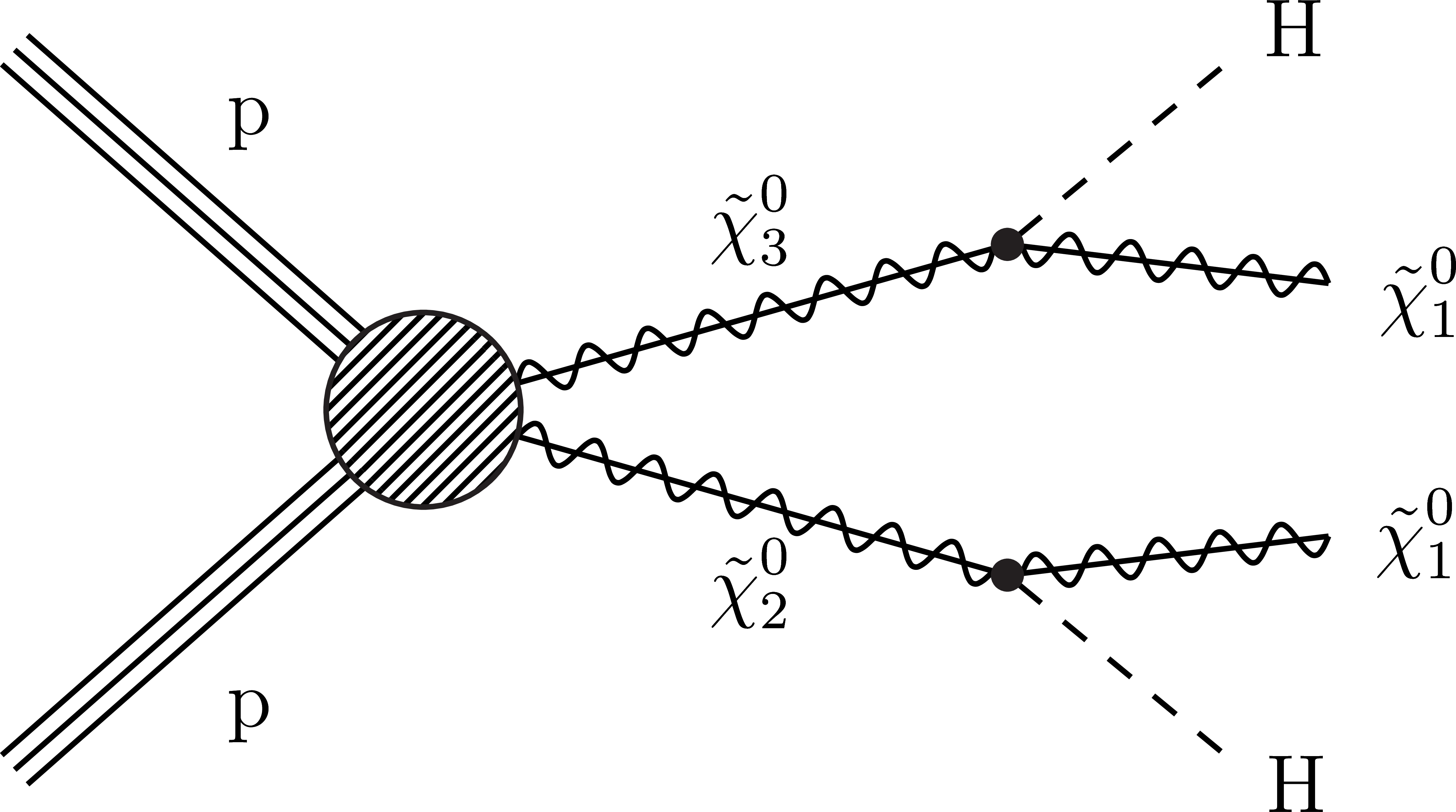
png pdf |
Figure 1-b:
Diagram for TChiHH, in which the electroweak production of two neutralinos leads to two Higgs bosons and two neutralinos ($\tilde{\chi}^0_1 $). The hatched circle represents the sum of processes that can lead to the SUSY particles shown. |
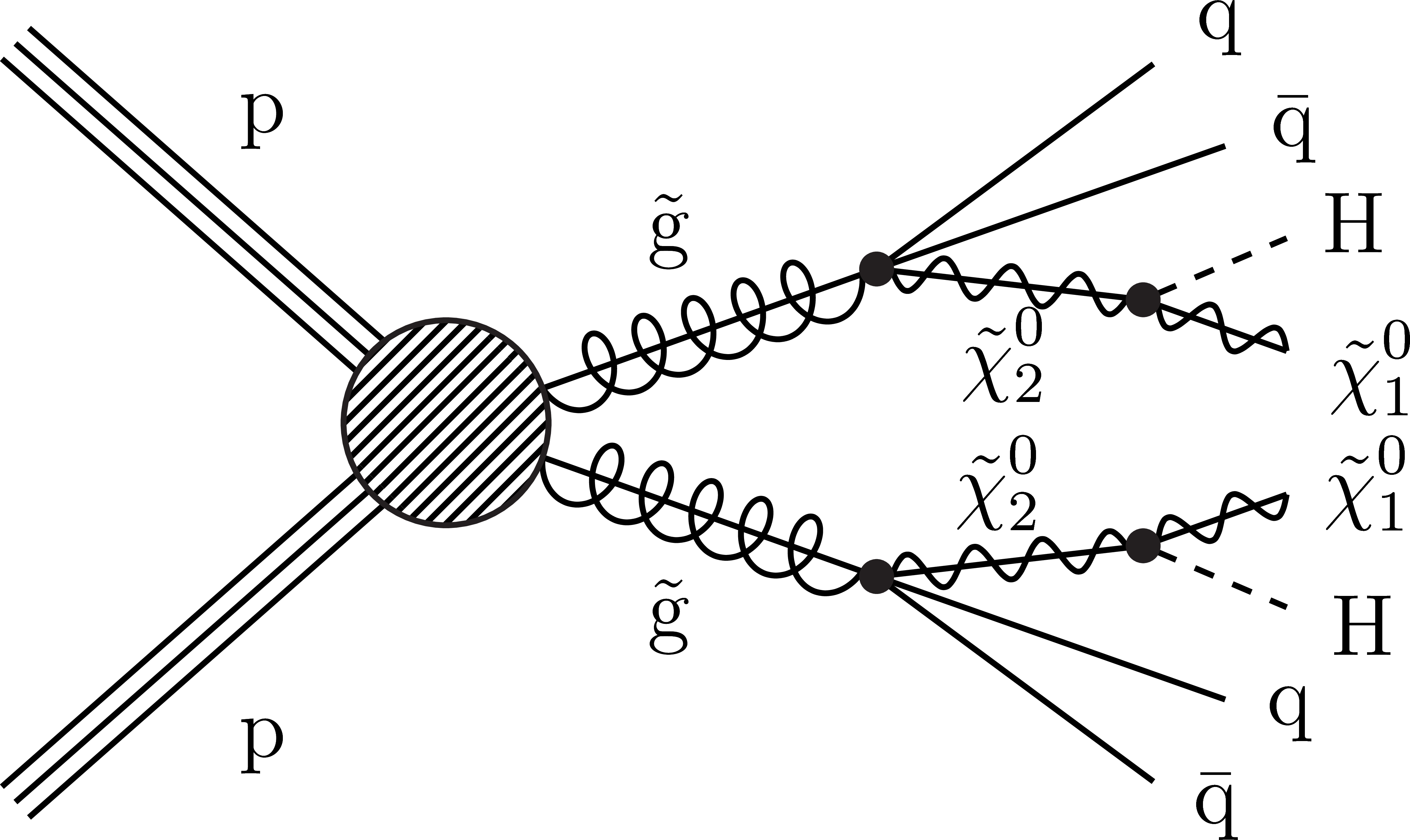
png pdf |
Figure 1-c:
Diagram for T5HH, the strong production of a pair of gluinos, each of which decays via a three-body process to quarks and a neutralino, with the neutralino subsequently decaying to a Higgs boson and a $\tilde{\chi}^0_1$ LSP. The hatched circle represents the sum of processes that can lead to the SUSY particles shown. |
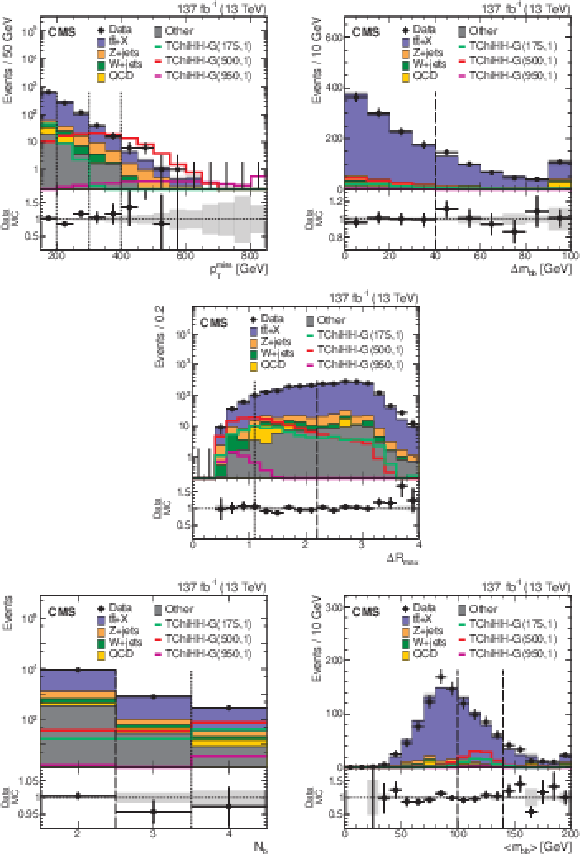
png pdf |
Figure 2:
Distributions in key analysis variables of the resolved signature for events satisfying the baseline requirements and $ {N_\mathrm{b}} =$ 3 or 4, except for those on the variable plotted: (upper left) ${{p_{\mathrm {T}}} ^\text {miss}}$, (upper right) ${\Delta m_{\mathrm{b} \mathrm{b}}}$, (middle) ${\Delta R_{\text {max}}}$, (lower left) ${N_\mathrm{b}}$, and (lower right) ${< m_{\mathrm{b} \mathrm{b}}>}$. The rightmost bins include the overflow entries. The data are shown as black markers with error bars, simulated SM backgrounds by the stacked histograms (scaled by factors of 0.93-0.97 to match the total data yield in each plot), and simulations of signals TChiHH-G($m(\tilde{\chi}^0_1),m(\tilde{\mathrm{G}}$) [GeV]) by the open colored histograms. Gray shading represents the statistical uncertainties of the simulation. Vertical lines indicate the boundaries for signal region selection (dashed), or for the signal region binning (dotted). The lower panels show the ratio of data to (scaled) simulation. |

png pdf |
Figure 2-a:
Distribution of ${{p_{\mathrm {T}}} ^\text {miss}}$ for events satisfying the baseline requirements and $ {N_\mathrm{b}} =$ 3 or 4. The rightmost bins includes the overflow entries. The data are shown as black markers with error bars, simulated SM backgrounds by the stacked histograms (scaled by a factor to match the total data yield), and simulations of signals TChiHH-G($m(\tilde{\chi}^0_1),m(\tilde{\mathrm{G}}$) [GeV]) by the open colored histograms. Gray shading represents the statistical uncertainties of the simulation. Vertical lines indicate the boundaries for signal region selection (dashed), or for the signal region binning (dotted). The lower panel shows the ratio of data to (scaled) simulation. |

png pdf |
Figure 2-b:
Distribution of ${\Delta m_{\mathrm{b} \mathrm{b}}}$ for events satisfying the baseline requirements and $ {N_\mathrm{b}} =$ 3 or 4. The rightmost bins includes the overflow entries. The data are shown as black markers with error bars, simulated SM backgrounds by the stacked histograms (scaled by a factor to match the total data yield), and simulations of signals TChiHH-G($m(\tilde{\chi}^0_1),m(\tilde{\mathrm{G}}$) [GeV]) by the open colored histograms. Gray shading represents the statistical uncertainties of the simulation. Vertical lines indicate the boundaries for signal region selection (dashed), or for the signal region binning (dotted). The lower panel shows the ratio of data to (scaled) simulation. |
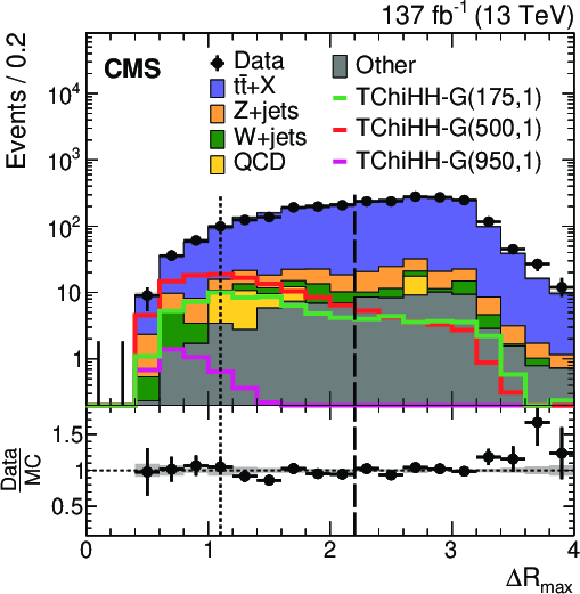
png pdf |
Figure 2-c:
Distribution of ${\Delta R_{\text {max}}}$ for events satisfying the baseline requirements and $ {N_\mathrm{b}} =$ 3 or 4. The rightmost bins includes the overflow entries. The data are shown as black markers with error bars, simulated SM backgrounds by the stacked histograms (scaled by a factor to match the total data yield), and simulations of signals TChiHH-G($m(\tilde{\chi}^0_1),m(\tilde{\mathrm{G}}$) [GeV]) by the open colored histograms. Gray shading represents the statistical uncertainties of the simulation. Vertical lines indicate the boundaries for signal region selection (dashed), or for the signal region binning (dotted). The lower panel shows the ratio of data to (scaled) simulation. |

png pdf |
Figure 2-d:
Distribution of ${N_\mathrm{b}}$ for events satisfying the baseline requirements and $ {N_\mathrm{b}} =$ 3 or 4. The rightmost bins includes the overflow entries. The data are shown as black markers with error bars, simulated SM backgrounds by the stacked histograms (scaled by a factor to match the total data yield), and simulations of signals TChiHH-G($m(\tilde{\chi}^0_1),m(\tilde{\mathrm{G}}$) [GeV]) by the open colored histograms. Gray shading represents the statistical uncertainties of the simulation. Vertical lines indicate the boundaries for signal region selection (dashed), or for the signal region binning (dotted). The lower panel shows the ratio of data to (scaled) simulation. |
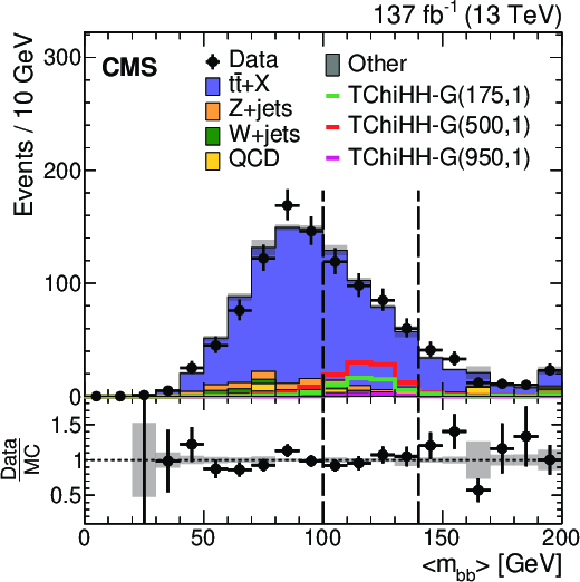
png pdf |
Figure 2-e:
Distributions of ${< m_{\mathrm{b} \mathrm{b}}>}$ for events satisfying the baseline requirements and $ {N_\mathrm{b}} =$ 3 or 4. The rightmost bins includes the overflow entries. The data are shown as black markers with error bars, simulated SM backgrounds by the stacked histograms (scaled by a factor to match the total data yield), and simulations of signals TChiHH-G($m(\tilde{\chi}^0_1),m(\tilde{\mathrm{G}}$) [GeV]) by the open colored histograms. Gray shading represents the statistical uncertainties of the simulation. Vertical lines indicate the boundaries for signal region selection (dashed), or for the signal region binning (dotted). The lower panel shows the ratio of data to (scaled) simulation. |

png pdf |
Figure 3:
Distributions in key analysis variables after the baseline requirements for the boosted signature, except for those on the variable plotted: (upper left) ${{p_{\mathrm {T}}} ^\text {miss}}$, (upper right) jet ${p_{\mathrm {T}}}$, (lower left) ${D_{ {\mathrm{b} \mathrm{b}}}}$, and (lower right) ${m_{\mathrm {J}}}$. Except for the ${{p_{\mathrm {T}}} ^\text {miss}}$ distribution, each plot contains two entries per event, for each of the two ${p_{\mathrm {T}}}$-leading AK8 jets. The data are shown by the black markers with error bars, and SM backgrounds from simulation (scaled by 86% to match the data integral) by the filled histograms. Open colored histograms show simulations of the signals TChiHH-G($m(\tilde{\chi}^0_1)$, $m(\tilde{\mathrm{G}})$) or T5HH($m({\mathrm{\widetilde{g}}})$, $m(\tilde{\chi}^0_1$)[GeV]). The vertical dashed lines show boundaries for the event classifications defined in Section 7: (upper left) the ${{p_{\mathrm {T}}} ^\text {miss}}$ binning; (lower left) the ${D_{ {\mathrm{b} \mathrm{b}}}}$ threshold for identification of a jet as an ${\mathrm{H} \to \mathrm{b} \mathrm{\bar{b}}}$ candidate; (lower right) the boundaries of the H boson mass window. The lower panel in each plot shows the ratio of observed to (scaled) simulated yields. |

png pdf |
Figure 3-a:
Distribution of ${{p_{\mathrm {T}}} ^\text {miss}}$ after the baseline requirements for the boosted signature. The data are shown by the black markers with error bars, and SM backgrounds from simulation (scaled by 86% to match the data integral) by the filled histograms. Open colored histograms show simulations of the signals TChiHH-G($m(\tilde{\chi}^0_1)$, $m(\tilde{\mathrm{G}})$) or T5HH($m({\mathrm{\widetilde{g}}})$, $m(\tilde{\chi}^0_1$)[GeV]). The vertical dashed lines show the ${{p_{\mathrm {T}}} ^\text {miss}}$ binning. The lower panel shows the ratio of observed to (scaled) simulated yields. |

png pdf |
Figure 3-b:
Distribution of jet ${p_{\mathrm {T}}}$ after the baseline requirements for the boosted signature, except for those on the variable plotted. The plot contains two entries per event, for each of the two ${p_{\mathrm {T}}}$-leading AK8 jets. The data are shown by the black markers with error bars, and SM backgrounds from simulation (scaled by 86% to match the data integral) by the filled histograms. Open colored histograms show simulations of the signals TChiHH-G($m(\tilde{\chi}^0_1)$, $m(\tilde{\mathrm{G}})$) or T5HH($m({\mathrm{\widetilde{g}}})$, $m(\tilde{\chi}^0_1$)[GeV]). The lower panel shows the ratio of observed to (scaled) simulated yields. |
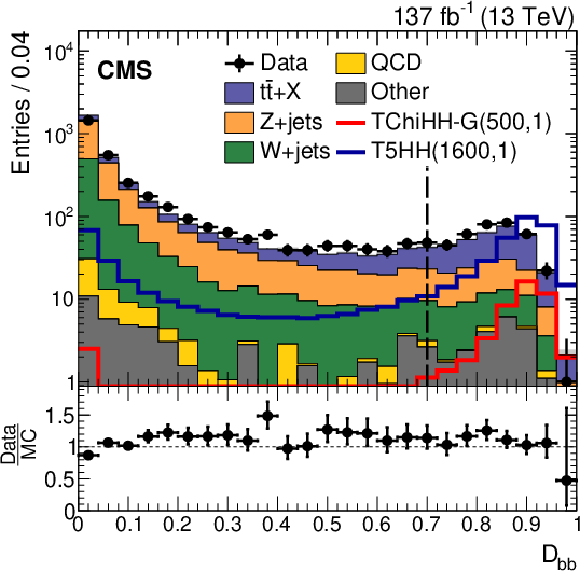
png pdf |
Figure 3-c:
Distribution of ${D_{ {\mathrm{b} \mathrm{b}}}}$ after the baseline requirements for the boosted signature. The plot contains two entries per event, for each of the two ${p_{\mathrm {T}}}$-leading AK8 jets. The data are shown by the black markers with error bars, and SM backgrounds from simulation (scaled by 86% to match the data integral) by the filled histograms. Open colored histograms show simulations of the signals TChiHH-G($m(\tilde{\chi}^0_1)$, $m(\tilde{\mathrm{G}})$) or T5HH($m({\mathrm{\widetilde{g}}})$, $m(\tilde{\chi}^0_1$)[GeV]). The vertical dashed line shows the ${D_{ {\mathrm{b} \mathrm{b}}}}$ threshold for identification of a jet as an ${\mathrm{H} \to \mathrm{b} \mathrm{\bar{b}}}$ candidate. The lower panel shows the ratio of observed to (scaled) simulated yields. |
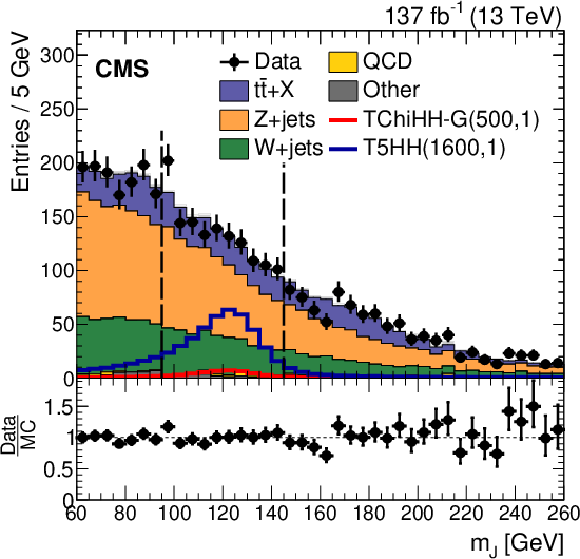
png pdf |
Figure 3-d:
Distribution of ${m_{\mathrm {J}}}$ after the baseline requirements for the boosted signature. The plot contains two entries per event, for each of the two ${p_{\mathrm {T}}}$-leading AK8 jets. The data are shown by the black markers with error bars, and SM backgrounds from simulation (scaled by 86% to match the data integral) by the filled histograms. Open colored histograms show simulations of the signals TChiHH-G($m(\tilde{\chi}^0_1)$, $m(\tilde{\mathrm{G}})$) or T5HH($m({\mathrm{\widetilde{g}}})$, $m(\tilde{\chi}^0_1$)[GeV]). The vertical dashed lines show the boundaries of the H boson mass window. The lower panel shows the ratio of observed to (scaled) simulated yields. |
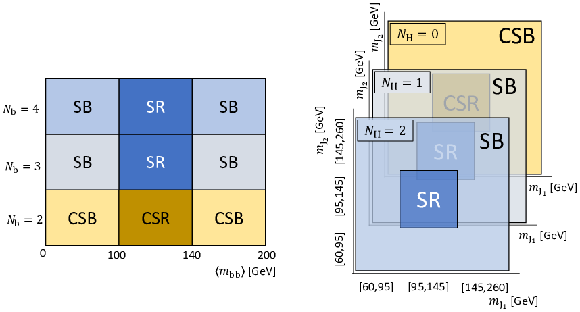
png pdf |
Figure 4:
Configuration of the signal and control regions for the (left) resolved and (right) boosted signatures. The patterns shown are repeated in each of several bins in kinematic or topological variables for improved sensitivity, as discussed in the text. |

png pdf |
Figure 5:
The double ratio $\kappa = ({N_{\text {SR}}} / {N_{\text {SB}}})/({N_{\text {CSR}}} / {N_{\text {CSB}}})$ from the SM simulation for the $ {N_\mathrm{b}} =$ 3 and $ {N_\mathrm{b}} =$ 4 search samples for each $({{p_{\mathrm {T}}} ^\text {miss}}$, ${\Delta R_{\text {max}}})$ bin of the resolved signature. The value $\Delta $ gives the deviation of ${\kappa}$ from unity, and $\sigma $ its relative statistical uncertainty. |
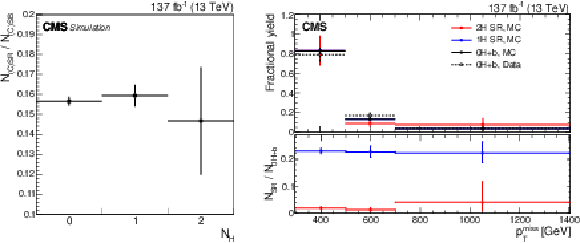
png pdf |
Figure 6:
(left) The yield ratios $ {N_{\text {CSR}}} / {N_{\text {CSB}}} $ for the 0H region, and $ {N_{\text {SR}}} / {N_{\text {SB}}} $ for 1H and 2H regions of the boosted signature, from the SM simulation. (right) The $ {{p_{\mathrm {T}}} ^\text {miss}} $ distributions of the 2H and 1H SR yields and the 0H+b control region yields, for SM simulation (MC, solid points), and for the control region in data (open black points). In the right-hand plot the upper panel shows the distributions normalized to unit area. The blue points, and in one bin the open point, are hidden under the solid black points. The lower panel shows the (unnormalized) ratios to the 0H+b yields of the 1H (blue) and 2H (red) SR yields, for the simulation. The error bars show the statistical uncertainties. |

png pdf |
Figure 6-a:
The yield ratios $ {N_{\text {CSR}}} / {N_{\text {CSB}}} $ for the 0H region, and $ {N_{\text {SR}}} / {N_{\text {SB}}} $ for 1H and 2H regions of the boosted signature, from the SM simulation. |

png pdf |
Figure 6-b:
The $ {{p_{\mathrm {T}}} ^\text {miss}} $ distributions of the 2H and 1H SR yields and the 0H+b control region yields, for SM simulation (MC, solid points), and for the control region in data (open black points). In the right-hand plot the upper panel shows the distributions normalized to unit area. The blue points, and in one bin the open point, are hidden under the solid black points. The lower panel shows the (unnormalized) ratios to the 0H+b yields of the 1H (blue) and 2H (red) SR yields, for the simulation. The error bars show the statistical uncertainties. |
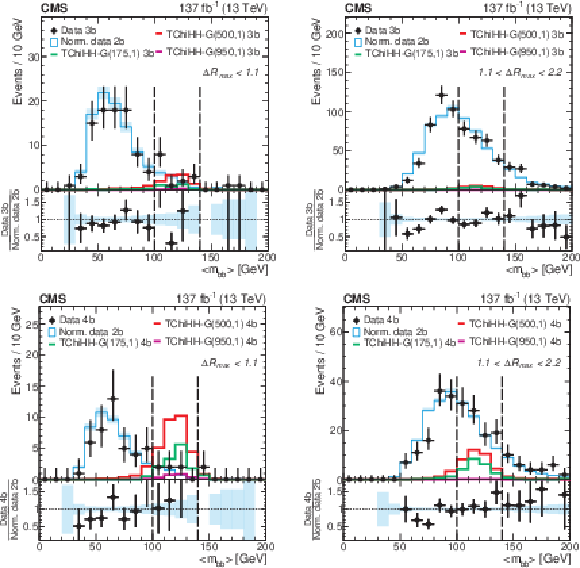
png pdf |
Figure 7:
Distributions in ${< m_{\mathrm{b} \mathrm{b}}>}$ for the (upper row) $ {N_\mathrm{b}} =$ 3 and (lower row) $ {N_\mathrm{b}} =$ 4 data, denoted by black markers, with error bars indicating the statistical uncertainties. The left-hand set of plots corresponds to $ {\Delta R_{\text {max}}} < $ 1.1, while the right-hand set corresponds to 1.1 $ < {\Delta R_{\text {max}}} < $ 2.2, in both cases integrated over ${{p_{\mathrm {T}}} ^\text {miss}}$. The overlaid cyan histograms show the corresponding distributions of the $ {N_\mathrm{b}} =$ 2 data, reweighted with the appropriate ${\kappa}$ values and scaled in area to the $ {N_\mathrm{b}} =$ 3 or $ {N_\mathrm{b}} =$ 4 distribution and with statistical uncertainties indicated by the cyan shading (absent in the 140-150 bin because of a vanishing $ {N_\mathrm{b}} =$ 2 yield there). The ratio of these distributions appears in the lower panel. The red, green, and violet histograms show simulations of representative signals, denoted TChiHH-G($m(\tilde{\chi}^0_1),m(\tilde{\mathrm{G}}$) [GeV]) in the legends. |
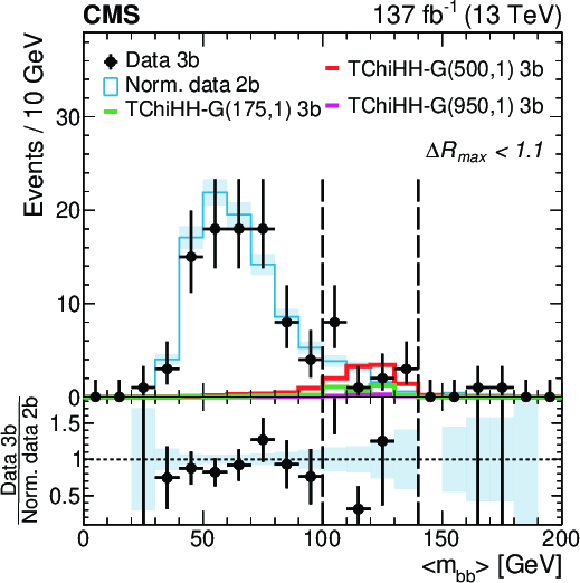
png pdf |
Figure 7-a:
Distribution in ${< m_{\mathrm{b} \mathrm{b}}>}$ for the $ {N_\mathrm{b}} =$ 3 data, denoted by black markers, with error bars indicating the statistical uncertainties. The plot corresponds to $ {\Delta R_{\text {max}}} < $ 1.1, integrated over ${{p_{\mathrm {T}}} ^\text {miss}}$. The overlaid cyan histogram shows the corresponding distributions of the $ {N_\mathrm{b}} =$ 2 data, reweighted with the appropriate ${\kappa}$ values and scaled in area to the $ {N_\mathrm{b}} =$ 3 distribution and with statistical uncertainties indicated by the cyan shading (absent in the 140-150 bin because of a vanishing $ {N_\mathrm{b}} =$ 2 yield there). The ratio of these distributions appears in the lower panel. The red, green, and violet histograms show simulations of representative signals, denoted TChiHH-G($m(\tilde{\chi}^0_1),m(\tilde{\mathrm{G}}$) [GeV]) in the legends. |
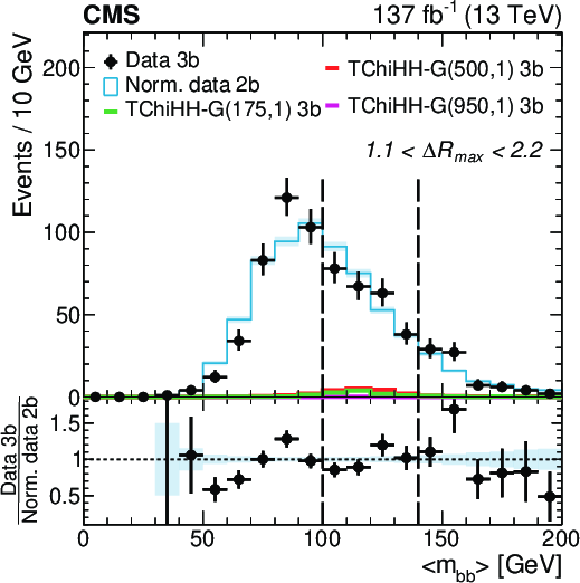
png pdf |
Figure 7-b:
Distribution in ${< m_{\mathrm{b} \mathrm{b}}>}$ for the $ {N_\mathrm{b}} =$ 3 data, denoted by black markers, with error bars indicating the statistical uncertainties. The plot corresponds to 1.1 $ < {\Delta R_{\text {max}}} < $ 2.2, integrated over ${{p_{\mathrm {T}}} ^\text {miss}}$. The overlaid cyan histogram shows the corresponding distributions of the $ {N_\mathrm{b}} =$ 2 data, reweighted with the appropriate ${\kappa}$ values and scaled in area to the $ {N_\mathrm{b}} =$ 3 distribution and with statistical uncertainties indicated by the cyan shading (absent in the 140-150 bin because of a vanishing $ {N_\mathrm{b}} =$ 2 yield there). The ratio of these distributions appears in the lower panel. The red, green, and violet histograms show simulations of representative signals, denoted TChiHH-G($m(\tilde{\chi}^0_1),m(\tilde{\mathrm{G}}$) [GeV]) in the legends. |
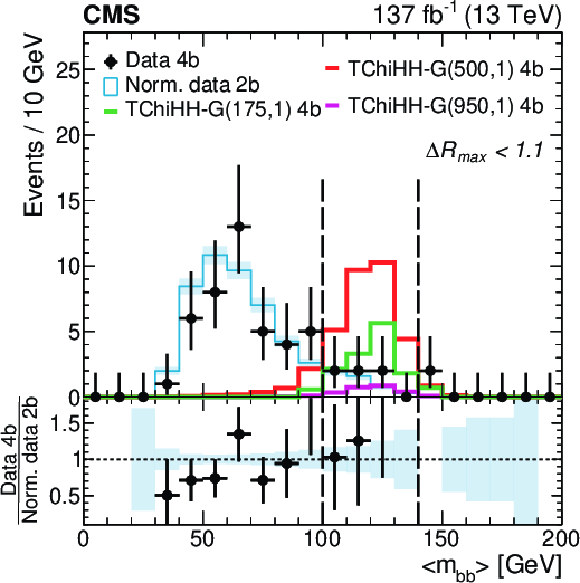
png pdf |
Figure 7-c:
Distribution in ${< m_{\mathrm{b} \mathrm{b}}>}$ for the $ {N_\mathrm{b}} =$ 4 data, denoted by black markers, with error bars indicating the statistical uncertainties. The plot corresponds to $ {\Delta R_{\text {max}}} < $ 1.1, integrated over ${{p_{\mathrm {T}}} ^\text {miss}}$. The overlaid cyan histogram shows the corresponding distributions of the $ {N_\mathrm{b}} =$ 2 data, reweighted with the appropriate ${\kappa}$ values and scaled in area to the $ {N_\mathrm{b}} =$ 4 distribution and with statistical uncertainties indicated by the cyan shading (absent in the 140-150 bin because of a vanishing $ {N_\mathrm{b}} =$ 2 yield there). The ratio of these distributions appears in the lower panel. The red, green, and violet histograms show simulations of representative signals, denoted TChiHH-G($m(\tilde{\chi}^0_1),m(\tilde{\mathrm{G}}$) [GeV]) in the legends. |

png pdf |
Figure 7-d:
Distribution in ${< m_{\mathrm{b} \mathrm{b}}>}$ for the $ {N_\mathrm{b}} =$ 4 data, denoted by black markers, with error bars indicating the statistical uncertainties. The plot corresponds to 1.1 $ < {\Delta R_{\text {max}}} < $ 2.2, integrated over ${{p_{\mathrm {T}}} ^\text {miss}}$. The overlaid cyan histogram shows the corresponding distributions of the $ {N_\mathrm{b}} =$ 2 data, reweighted with the appropriate ${\kappa}$ values and scaled in area to the $ {N_\mathrm{b}} =$ 4 distribution and with statistical uncertainties indicated by the cyan shading (absent in the 140-150 bin because of a vanishing $ {N_\mathrm{b}} =$ 2 yield there). The ratio of these distributions appears in the lower panel. The red, green, and violet histograms show simulations of representative signals, denoted TChiHH-G($m(\tilde{\chi}^0_1),m(\tilde{\mathrm{G}}$) [GeV]) in the legends. |

png pdf |
Figure 8:
Distributions in ${< m_{\mathrm{b} \mathrm{b}}>}$ for the (upper row) $ {N_\mathrm{b}} =$ 3 and (lower row) $ {N_\mathrm{b}} =$ 4 data, denoted by black markers, with error bars indicating the statistical uncertainties. The left-hand set of plots corresponds to 150 $ < {{p_{\mathrm {T}}} ^\text {miss}} < $ 200, while the right-hand set corresponds to $ {{p_{\mathrm {T}}} ^\text {miss}} > $ 200 GeV, in both cases integrated over ${\Delta R_{\text {max}}}$. The overlaid cyan histograms show the corresponding distributions of the $ {N_\mathrm{b}} =$ 2 data, reweighted with the appropriate ${\kappa}$ values and scaled in area to the $ {N_\mathrm{b}} =$ 3 or $ {N_\mathrm{b}} =$ 4 distribution and with statistical uncertainties indicated by the cyan shading. The ratio of these distributions appears in the lower panel. The red, green, and violet histograms show simulations of representative signals, denoted TChiHH-G($m(\tilde{\chi}^0_1),m(\tilde{\mathrm{G}}$) [GeV]) in the legends. |
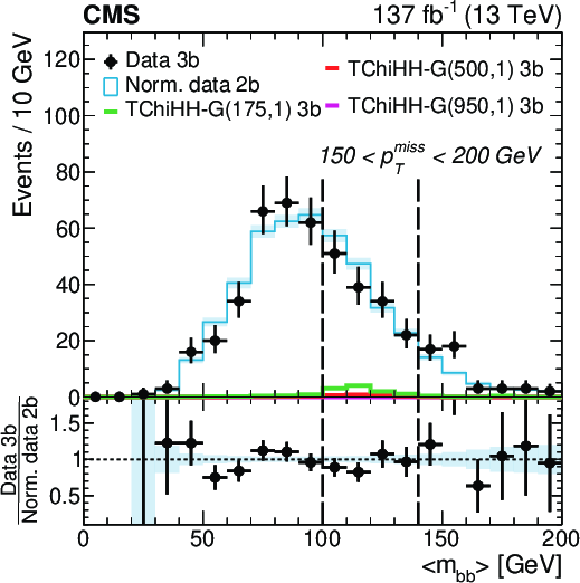
png pdf |
Figure 8-a:
Distribution in ${< m_{\mathrm{b} \mathrm{b}}>}$ for the $ {N_\mathrm{b}} =$ 3 data, denoted by black markers, with error bars indicating the statistical uncertainties. The plot corresponds to 150 $ < {{p_{\mathrm {T}}} ^\text {miss}} < $ 200, integrated over ${\Delta R_{\text {max}}}$. The overlaid cyan histogram shows the corresponding distributions of the $ {N_\mathrm{b}} =$ 2 data, reweighted with the appropriate ${\kappa}$ values and scaled in area to the $ {N_\mathrm{b}} =$ 3 4 distribution and with statistical uncertainties indicated by the cyan shading. The ratio of these distributions appears in the lower panel. The red, green, and violet histograms show simulations of representative signals, denoted TChiHH-G($m(\tilde{\chi}^0_1),m(\tilde{\mathrm{G}}$) [GeV]) in the legends. |

png pdf |
Figure 8-b:
Distribution in ${< m_{\mathrm{b} \mathrm{b}}>}$ for the $ {N_\mathrm{b}} =$ 3 data, denoted by black markers, with error bars indicating the statistical uncertainties. The plot corresponds to $ {{p_{\mathrm {T}}} ^\text {miss}} > $ 200 GeV, integrated over ${\Delta R_{\text {max}}}$. The overlaid cyan histogram shows the corresponding distributions of the $ {N_\mathrm{b}} =$ 2 data, reweighted with the appropriate ${\kappa}$ values and scaled in area to the $ {N_\mathrm{b}} =$ 3 4 distribution and with statistical uncertainties indicated by the cyan shading. The ratio of these distributions appears in the lower panel. The red, green, and violet histograms show simulations of representative signals, denoted TChiHH-G($m(\tilde{\chi}^0_1),m(\tilde{\mathrm{G}}$) [GeV]) in the legends. |
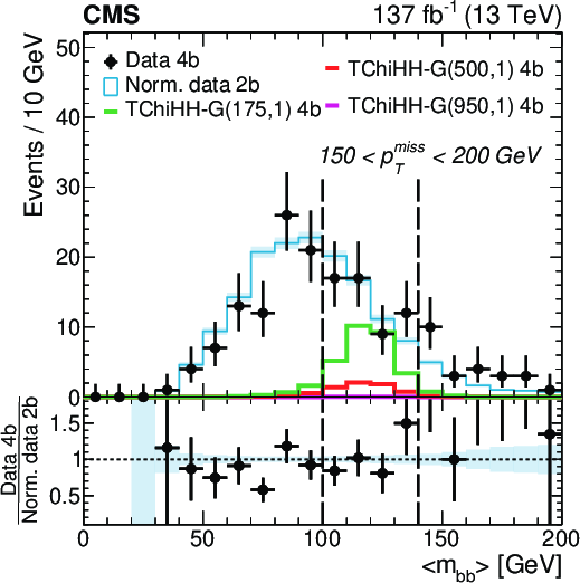
png pdf |
Figure 8-c:
Distribution in ${< m_{\mathrm{b} \mathrm{b}}>}$ for the $ {N_\mathrm{b}} =$ 4 data, denoted by black markers, with error bars indicating the statistical uncertainties. The plot corresponds to 150 $ < {{p_{\mathrm {T}}} ^\text {miss}} < $ 200, integrated over ${\Delta R_{\text {max}}}$. The overlaid cyan histogram shows the corresponding distributions of the $ {N_\mathrm{b}} =$ 2 data, reweighted with the appropriate ${\kappa}$ values and scaled in area to the $ {N_\mathrm{b}} =$ 3 4 distribution and with statistical uncertainties indicated by the cyan shading. The ratio of these distributions appears in the lower panel. The red, green, and violet histograms show simulations of representative signals, denoted TChiHH-G($m(\tilde{\chi}^0_1),m(\tilde{\mathrm{G}}$) [GeV]) in the legends. |
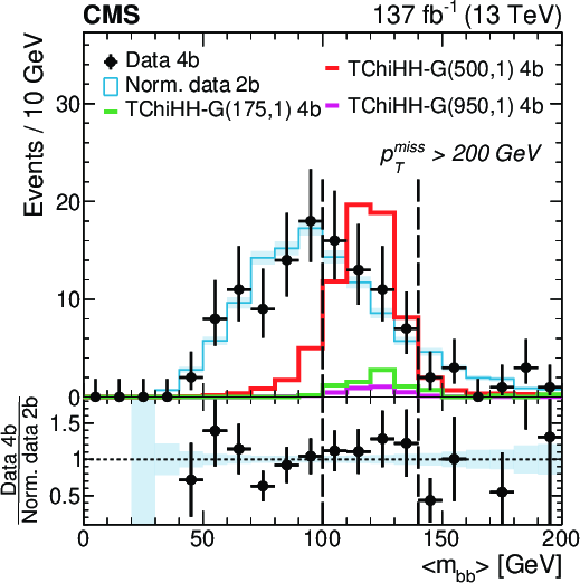
png pdf |
Figure 8-d:
Distribution in ${< m_{\mathrm{b} \mathrm{b}}>}$ for the $ {N_\mathrm{b}} =$ 4 data, denoted by black markers, with error bars indicating the statistical uncertainties. The plot corresponds to $ {{p_{\mathrm {T}}} ^\text {miss}} > $ 200 GeV, integrated over ${\Delta R_{\text {max}}}$. The overlaid cyan histogram shows the corresponding distributions of the $ {N_\mathrm{b}} =$ 2 data, reweighted with the appropriate ${\kappa}$ values and scaled in area to the $ {N_\mathrm{b}} =$ 3 4 distribution and with statistical uncertainties indicated by the cyan shading. The ratio of these distributions appears in the lower panel. The red, green, and violet histograms show simulations of representative signals, denoted TChiHH-G($m(\tilde{\chi}^0_1),m(\tilde{\mathrm{G}}$) [GeV]) in the legends. |

png pdf |
Figure 9:
Distributions in ${m_{\mathrm {J}}}$ for the boosted signature, integrated in ${{p_{\mathrm {T}}} ^\text {miss}}$. The projections (left column) contain two entries per event, with statistical uncertainties in the data and simulation given by the vertical bars and gray shading, respectively. The SM yields are scaled to the data integral, by factors of 0.84, 0.92, and 1.13 in the 0H (upper), 1H (middle), and 2H (lower) plots, respectively. The data to simulation ratio appears in each lower panel. Simulated signals TChiHH-G($m(\tilde{\chi}^0_1)$, $m(\tilde{\mathrm{G}})$) and T5HH($m({\mathrm{\widetilde{g}}})$, $m(\tilde{\chi}^0_1$)[GeV]) are also shown. In the correlation plots (right column) the color scale represents the SM background, black dots the data, and red dots the expected signal. The dashed lines and boxes denote the boundaries of the SRs. |
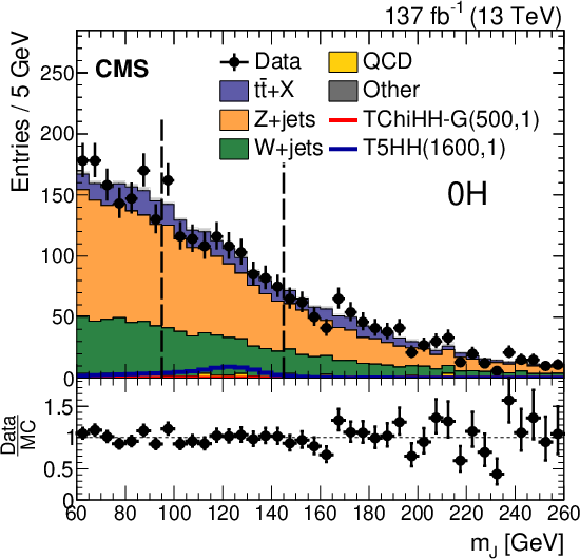
png pdf |
Figure 9-a:
Distribution in ${m_{\mathrm {J}}}$ for the boosted signature, integrated in ${{p_{\mathrm {T}}} ^\text {miss}}$, in the 0H region. The projection contains two entries per event, with statistical uncertainties in the data and simulation given by the vertical bars and gray shading, respectively. The SM yield is scaled to the data integral, by a factor of 0.84. The data to simulation ratio appears in the lower panel. Simulated signals TChiHH-G($m(\tilde{\chi}^0_1)$, $m(\tilde{\mathrm{G}})$) and T5HH($m({\mathrm{\widetilde{g}}})$, $m(\tilde{\chi}^0_1$)[GeV]) are also shown. The dashed lines denote the boundaries of the SR. |

png pdf |
Figure 9-b:
Distribution in ${m_{\mathrm {J}}}$ for the boosted signature, integrated in ${{p_{\mathrm {T}}} ^\text {miss}}$, in the 0H region. Correlation plot, where the color scale represents the SM background, black dots the data, and red dots the expected signal. The dashed box denotes the boundary of the SR. |

png pdf |
Figure 9-c:
Distribution in ${m_{\mathrm {J}}}$ for the boosted signature, integrated in ${{p_{\mathrm {T}}} ^\text {miss}}$, in the 1H region. The projection contains two entries per event, with statistical uncertainties in the data and simulation given by the vertical bars and gray shading, respectively. The SM yield is scaled to the data integral, by a factor of 0.92. The data to simulation ratio appears in the lower panel. Simulated signals TChiHH-G($m(\tilde{\chi}^0_1)$, $m(\tilde{\mathrm{G}})$) and T5HH($m({\mathrm{\widetilde{g}}})$, $m(\tilde{\chi}^0_1$)[GeV]) are also shown. The dashed lines denote the boundaries of the SR. |

png pdf |
Figure 9-d:
Distribution in ${m_{\mathrm {J}}}$ for the boosted signature, integrated in ${{p_{\mathrm {T}}} ^\text {miss}}$, in the 1H region. Correlation plot, where the color scale represents the SM background, black dots the data, and red dots the expected signal. The dashed box denotes the boundary of the SR. |

png pdf |
Figure 9-e:
Distribution in ${m_{\mathrm {J}}}$ for the boosted signature, integrated in ${{p_{\mathrm {T}}} ^\text {miss}}$, in the 2H region. The projection contains two entries per event, with statistical uncertainties in the data and simulation given by the vertical bars and gray shading, respectively. The SM yield is scaled to the data integral, by a factor of 1.13. The data to simulation ratio appears in the lower panel. Simulated signals TChiHH-G($m(\tilde{\chi}^0_1)$, $m(\tilde{\mathrm{G}})$) and T5HH($m({\mathrm{\widetilde{g}}})$, $m(\tilde{\chi}^0_1$)[GeV]) are also shown. The dashed lines denote the boundaries of the SR. |
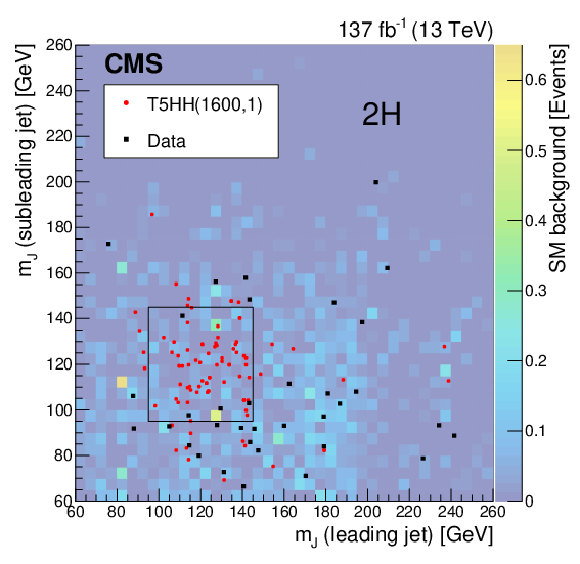
png pdf |
Figure 9-f:
Distribution in ${m_{\mathrm {J}}}$ for the boosted signature, integrated in ${{p_{\mathrm {T}}} ^\text {miss}}$, in the 2H region. Correlation plot, where the color scale represents the SM background, black dots the data, and red dots the expected signal. The dashed box denotes the boundary of the SR. |
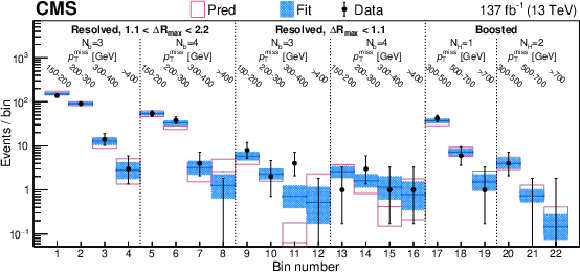
png pdf root |
Figure 10:
Observed and predicted yields in the search regions identified by the legend text. The points with error bars represent the observed yields, the magenta outline bands the predicted background yields ("Pred'') with their total uncertainties derived as described in Sections 7 and 8, and the blue shaded bands the values determined by the background-only fit ("Fit''). |
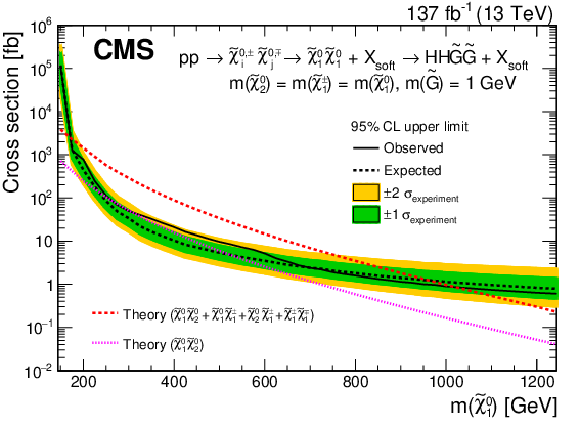
png pdf root |
Figure 11:
Observed and expected upper limits at 95% CL on the cross section for the GMSB-motivated simplified model TChiHH-G. The symbol $\text {X}_{\text {soft}}$ in the legend represents low-energy particles emitted in the transitions to the $\tilde{\chi}^0_1$ NLSPs. The dashed black line with green and yellow bands shows the expected limit with its 1- and 2-s.d. uncertainties, while the solid black line shows the observed limit. The theoretical cross section is indicated by the dashed red line under the assumption that the decay chains leading to the $\tilde{\chi}^0_1 \tilde{\chi}^0_1 $ intermediate state include a degenerate set of all charginos and neutralinos, and by the dotted magenta line under the assumption that only the combination $\tilde{\chi}^0_1 \tilde{\chi}^0_2 $ contributes. |

png pdf |
Figure 12:
Separate resolved-signature (blue) and boosted-signature (red) contributions to the cross section limits for the GMSB-motivated simplified model TChiHH-G shown in Fig. 11. Here no overlapping events were removed. The symbol $\text {X}_{\text {soft}}$ in the legend represents low-energy particles emitted in the transitions to the $\tilde{\chi}^0_1$ NLSPs. The solid and dashed lines, respectively, give the observed and expected upper limits at 95% CL. The dashed black line shows the theoretical cross section computed under the assumption that the decay chains leading to the $\tilde{\chi}^0_1 \tilde{\chi}^0_1 $ intermediate state include a degenerate set of all charginos and neutralinos. |

png pdf root |
Figure 13:
Limits at 95% CL on the cross section for the TChiHH signal model in which production of the intermediate state $\tilde{\chi}^0_2 \tilde{\chi}^0_3 $ (assumed mass degenerate) is followed by the decay of each to $\tilde{\chi}^0_1 \mathrm{H} $. The color scale gives the cross section limit as a function of $(m(\tilde{\chi}^0_2),m(\tilde{\chi}^0_1))$. The black solid and dashed curves show the observed excluded region and its 1-s.d. uncertainty. The red solid and dashed (dotted) contours show the expected excluded region with its 1 (2)-s.d. uncertainty. |
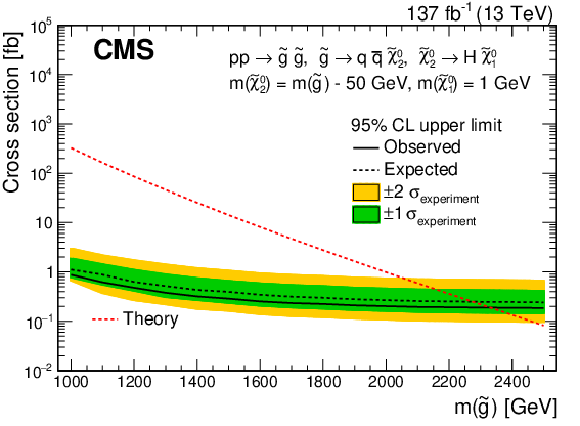
png pdf root |
Figure 14:
Observed and expected upper limits at 95% CL on the cross section for the simplified model T5HH, the strong production of a pair of gluinos each of which decays via a three-body process to quarks and a $\tilde{\chi}^0_2$ NLSP, which subsequently decays to a Higgs boson and a $\tilde{\chi}^0_1$ LSP. The dashed black line with green and yellow bands shows the expected limit with its 1- and 2-s.d. uncertainties; the solid black line shows the observed limit, and the dashed red line the theoretical cross section. |
| Tables | |
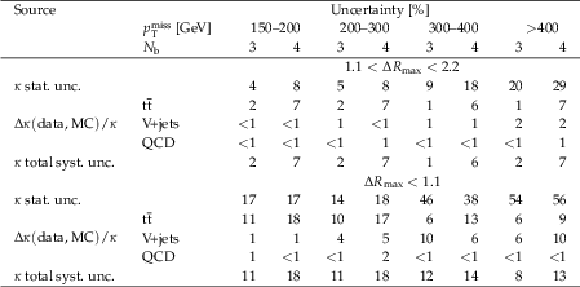
png pdf |
Table 1:
Summary of the uncertainties in ${\kappa}$ for the resolved signature. The sources are statistical uncertainties in the determination of ${\kappa}$ and the systematic uncertainties $\Delta \kappa (\text {data, MC})/\kappa $ derived from the comparison of simulation with data in the single-lepton, dilepton, and low-${\Delta \phi}$ control samples, each weighted by the fraction of background arising from the associated process in each search bin. |
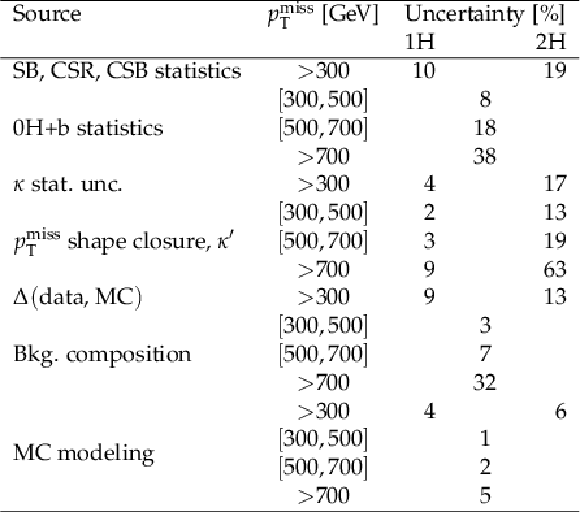
png pdf |
Table 2:
Summary of systematic uncertainties in the background prediction for the boosted signature. Values in cells spanning the 1H and 2H columns affect only ${f_{\text {pTmiss}}}$. The values from the ABCD measurement with the ${p_{\mathrm {T}}}$-integrated sample appear in the rows labeled $ {{p_{\mathrm {T}}} ^\text {miss}} > $ 300 GeV. The row labeled $\Delta (\text {data, MC})$ gives the contribution derived from the comparison of simulation with data in the one-lepton control sample. |
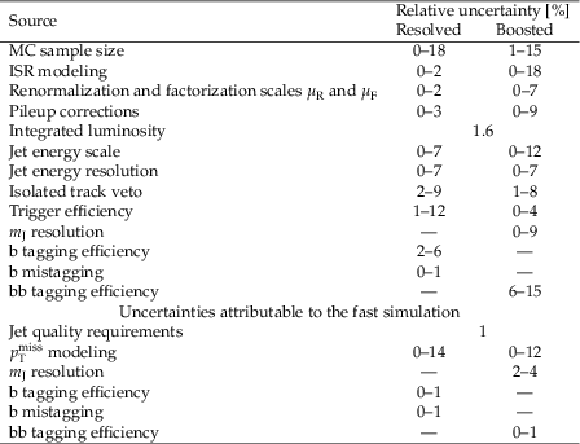
png pdf |
Table 3:
Sources of systematic uncertainties and their typical impact on the signal yields obtained from simulation. The range is reported as the median 68% confidence interval among all signal regions for every signal mass point considered. Entries reported as 0 correspond to values smaller than 0.5%. |

png pdf |
Table 4:
For each SR of the resolved signature, the MC correction factor ${\kappa}$, predicted background yield ${N_{\text {SR}}^{\text {pred}}}$, yield from the background-only ($\mu =$ 0) fit ${N_{\text {SR}}^{\text {fit}}}$, and observed yield ${N_{\text {SR}}^{\text {obs}}}$. The first and second uncertainties in the ${\kappa}$ factors are statistical and systematic, respectively. The uncertainties in ${N_{\text {SR}}^{\text {pred}}}$ and ${N_{\text {SR}}^{\text {fit}}}$, extracted from the maximum likelihood fit, include both statistical and systematic contributions. The interpretation of the results in bin 11 is discussed in the text. |

png pdf |
Table 5:
For each ${N_{\mathrm {\mathrm{H}}}}$ SR of the boosted signature, the total predicted background yield ${N_{\text {SR, tot}}^{\text {pred}}}$, and for each ${{p_{\mathrm {T}}} ^\text {miss}}$ bin the fraction ${f_{\text {pTmiss}}}$, both with their statistical uncertainties, the predicted background yield ${N_{\text {SR}}^{\text {pred}}}$, the yield from the background-only ($\mu =$ 0) fit ${N_{\text {SR}}^{\text {fit}}}$, and the observed yield ${N_{\text {SR}}^{\text {obs}}}$. The values of ${N_{\text {SR}}^{\text {pred}}}$ and ${N_{\text {SR}}^{\text {fit}}}$ are extracted from the maximum likelihood fit, with uncertainties that include both statistical and systematic contributions. |
| Summary |
|
A search has been presented for physics beyond the standard model in channels leading to pairs of Higgs bosons and an imbalance of transverse momentum, produced in proton-proton collisions at $\sqrt{s} = $ 13 TeV. The data sample, collected by the CMS experiment at the LHC, corresponds to an integrated luminosity of 137 fb$^{-1}$. The Higgs bosons are reconstructed via their decay to a pair of b quarks, observed either as distinct b quark jets (resolved signature), or as wide-angle jets that each contain the pair of b quarks (boosted signature). The observed event yields in 15 of the 16 analysis bins of the resolved signature, and all 6 bins of the boosted signature, are consistent with the background predictions based on SM processes. In one bin of the resolved signature, an excess is observed, for which the global significance is 2.1 standard deviations when all 16 bins are considered. A narrow, single-bin effect is not typical of the supersymmetry (SUSY) models under consideration. These results are used to set limits on the cross sections for the production of particles predicted by SUSY, considering both the direct production of neutralinos and their production through intermediate states with gluinos. For the electroweak production of nearly-degenerate higgsinos, each of whose decay cascades yields a ${\tilde{\chi}^0_1}$ that in turn decays through a Higgs boson to the lightest SUSY particle (LSP), a massless goldstino, $\tilde{\chi}^0_1$ masses in the range 175-1025 GeV are excluded at 95% confidence level. For a model with a mass splitting between the directly produced, degenerate higgsinos $\tilde{\chi}^0_2 \tilde{\chi}^0_3$, and a bino LSP, a small region where $m(\tilde{\chi}^0_1)$ is less than 15 GeV is excluded; for $m(\tilde{\chi}^0_1) = $ 1 GeV the excluded range of $m(\tilde{\chi}^0_2)$ is 265-305 GeV. For the strong production of gluino pairs decaying via a slightly lighter $\tilde{\chi}^0_2$ to a Higgs boson and a light $\tilde{\chi}^0_1$ LSP, gluino masses below 2330 GeV are excluded. The bounds on masses found here extend previous limits for these models by about 150 and 320 GeV for the $\tilde{\chi}^0_1$ and gluino, respectively. |
| Additional Figures | |
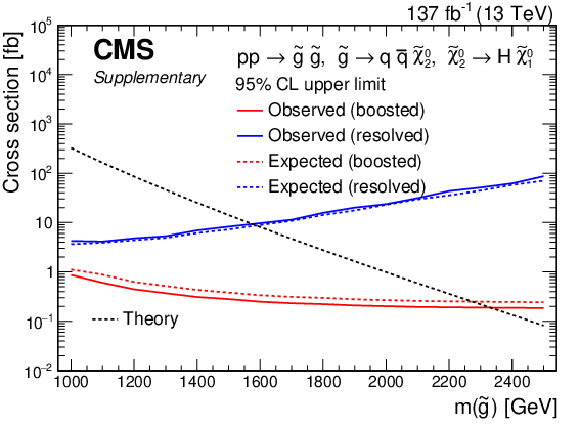
png pdf |
Additional Figure 1:
Upper limit exclusion at 95% CL for the gluino model T5HH shown for the boosted-only and resolved-only approaches, comparing expected and observed. Overlapping events were not removed. |
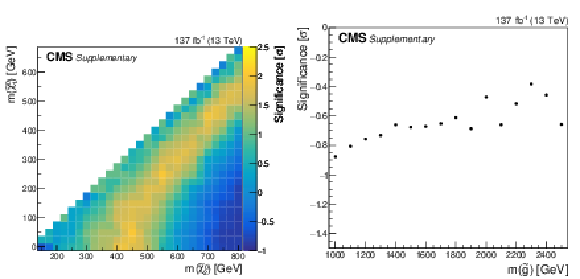
png pdf |
Additional Figure 2:
The significance scan for the TChiHH model (a) and the T5HH model (b) for the combination of resolved and boosted signatures. The value of the significance is signed negative where the best-fit value of the signal strength is negative (observation is less than the background estimate). The highest significance for the TChiHH model is 2.0$\sigma $ at the $ m(\tilde{\chi}_2^0)= $ 450 GeV, $ m(\tilde{\chi}^0_1)=$ 50 GeV mass point. |
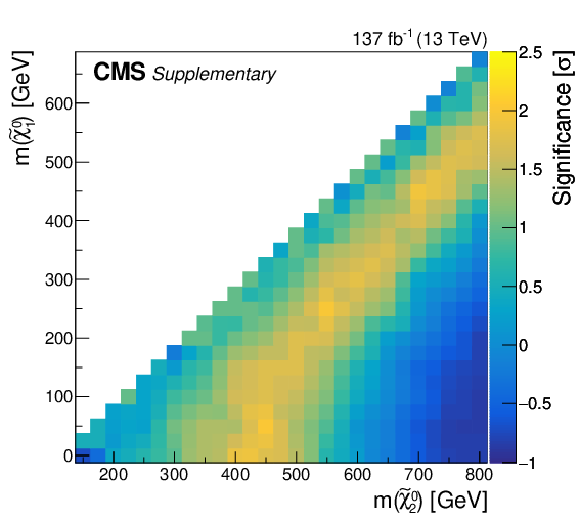
png pdf root |
Additional Figure 2-a:
The significance scan for the T5HH model for the combination of resolved and boosted signatures. The value of the significance is signed negative where the best-fit value of the signal strength is negative (observation is less than the background estimate). |
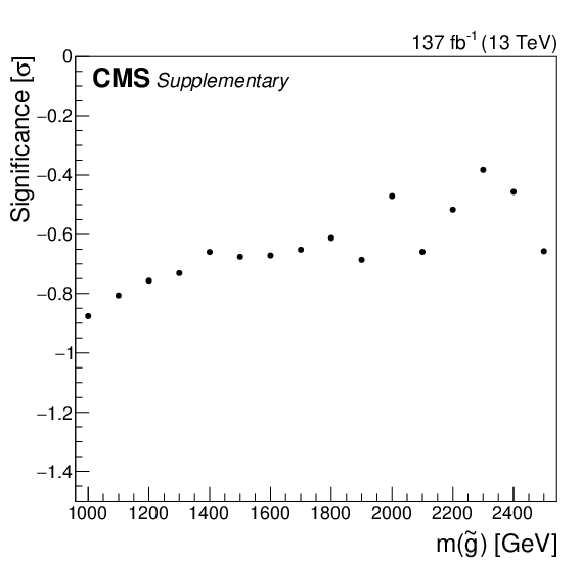
png pdf root |
Additional Figure 2-b:
The significance scan for the TChiHH model (a) and the T5HH model (b) for the combination of resolved and boosted signatures. The value of the significance is signed negative where the best-fit value of the signal strength is negative (observation is less than the background estimate). The highest significance for the TChiHH model is 2.0$\sigma $ at the $ m(\tilde{\chi}_2^0)= $ 450 GeV, $ m(\tilde{\chi}^0_1)=$ 50 GeV mass point. |
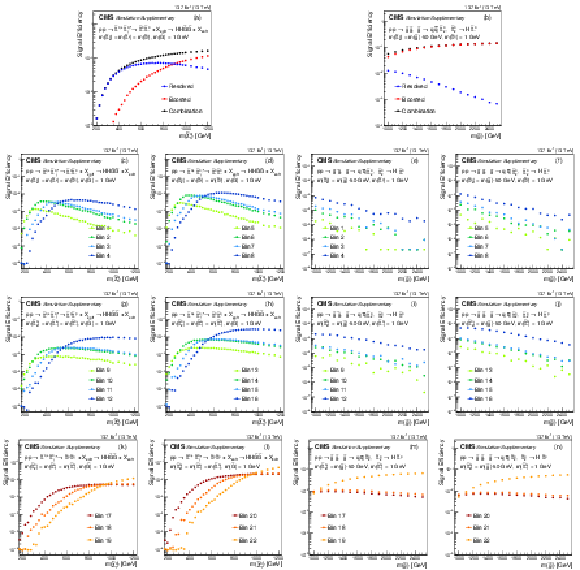
png pdf |
Additional Figure 3:
Efficiency by signal region for the TChiHH-G model, $\tilde{\chi}^0_1 \tilde{\chi}^0_1 \to \mathrm{H} \mathrm{H} \tilde{\mathrm{G}} \tilde{\mathrm{G}} $ (left two columns), or the T5HH model, ${\mathrm{\widetilde{g}}} {\mathrm{\widetilde{g}}} \to \mathrm{q} \mathrm{\bar{q}} \mathrm{H} \mathrm{H} \tilde{\chi}^0_1 \tilde{\chi}^0_1 $ (right two columns). In the first row (a, b) are shown the resolved-only topology, bins 1-16 (blue), the boosted-only topology, bins 17-22 (red), and all bins 1-22 (black). In the remaining rows are shown: (c, e) bins 1-4; (d, f) bins 5-8; (g, h) bins 9-12; (i, j) bins 13-16; (k, m) bins 17-19; and (l, n) bins 20-22. The data within plots are given, in increasing order of bin number, by colors ranging from light green to blue (c-j) or red to light orange (k-n). The SR indexing is given in Tables 4 and 5 of the paper. The denominator for the efficiency calculation of the TChiHH-G model includes only $\mathrm{H} \to \mathrm{b} \mathrm{\bar{b}} $ decays (for all SRs). |
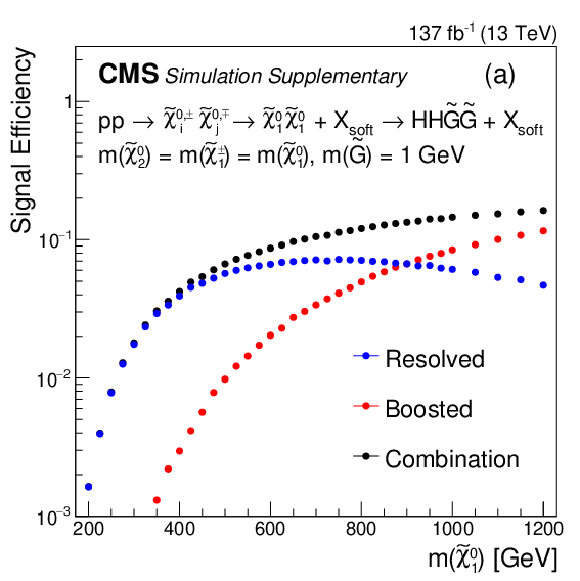
png pdf root |
Additional Figure 3-a:
Efficiency by signal region for the TChiHH-G model, $\tilde{\chi}^0_1 \tilde{\chi}^0_1 \to \mathrm{H} \mathrm{H} \tilde{\mathrm{G}} \tilde{\mathrm{G}} $. In this plot are shown the resolved-only topology, bins 1-16 (blue), the boosted-only topology, bins 17-22 (red), and all bins 1-22 (black). The SR indexing is given in Tables 4 and 5 of the paper. The denominator for the efficiency calculation includes only $\mathrm{H} \to \mathrm{b} \mathrm{\bar{b}} $ decays (for all SRs). |
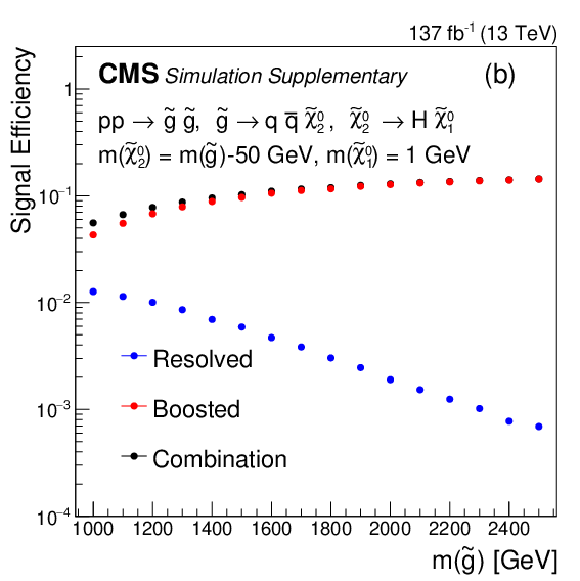
png pdf root |
Additional Figure 3-b:
Efficiency by signal region for the T5HH model, ${\mathrm{\widetilde{g}}} {\mathrm{\widetilde{g}}} \to \mathrm{q} \mathrm{\bar{q}} \mathrm{H} \mathrm{H} \tilde{\chi}^0_1 \tilde{\chi}^0_1 $. In this plot are shown the resolved-only topology, bins 1-16 (blue), the boosted-only topology, bins 17-22 (red), and all bins 1-22 (black). |
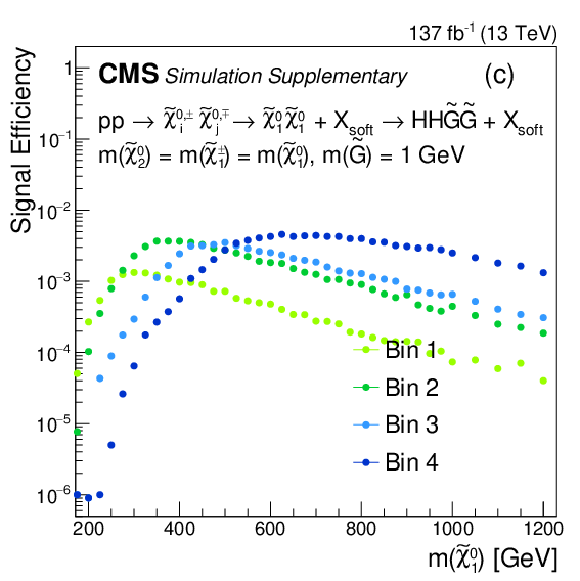
png pdf root |
Additional Figure 3-c:
Efficiency by signal region for the TChiHH-G model, $\tilde{\chi}^0_1 \tilde{\chi}^0_1 \to \mathrm{H} \mathrm{H} \tilde{\mathrm{G}} \tilde{\mathrm{G}} $. In this plot are shown bins 1-4. The data within the plot are given, in increasing order of bin number, by colors ranging from light green to blue. The SR indexing is given in Tables 4 and 5 of the paper. The denominator for the efficiency calculation includes only $\mathrm{H} \to \mathrm{b} \mathrm{\bar{b}} $ decays (for all SRs). |
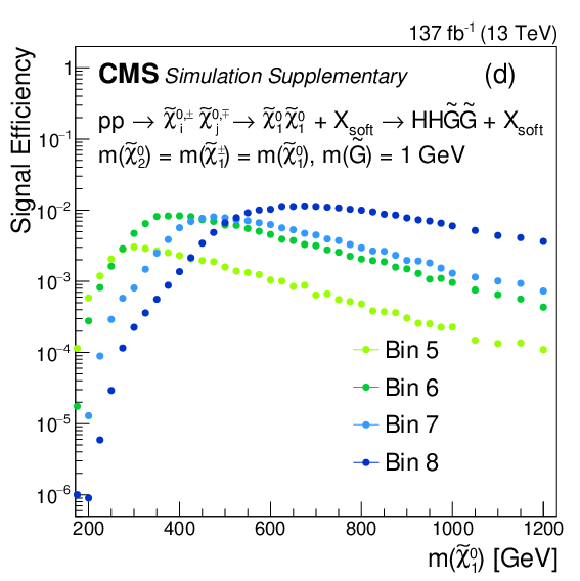
png pdf root |
Additional Figure 3-d:
Efficiency by signal region for the TChiHH-G model, $\tilde{\chi}^0_1 \tilde{\chi}^0_1 \to \mathrm{H} \mathrm{H} \tilde{\mathrm{G}} \tilde{\mathrm{G}} $. In this plot are shown bins 5-8. The data within the plot are given, in increasing order of bin number, by colors ranging from light green to blue. The SR indexing is given in Tables 4 and 5 of the paper. The denominator for the efficiency calculation includes only $\mathrm{H} \to \mathrm{b} \mathrm{\bar{b}} $ decays (for all SRs). |

png pdf root |
Additional Figure 3-e:
Efficiency by signal region for the T5HH model, ${\mathrm{\widetilde{g}}} {\mathrm{\widetilde{g}}} \to \mathrm{q} \mathrm{\bar{q}} \mathrm{H} \mathrm{H} \tilde{\chi}^0_1 \tilde{\chi}^0_1 $. In this plot are shown bins 1-4. The data within the plot are given, in increasing order of bin number, by colors ranging from light green to blue. The SR indexing is given in Tables 4 and 5 of the paper. |
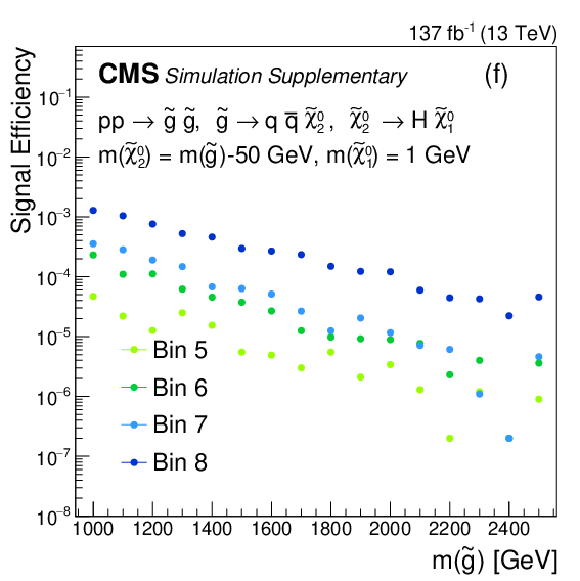
png pdf root |
Additional Figure 3-f:
Efficiency by signal region for the T5HH model, ${\mathrm{\widetilde{g}}} {\mathrm{\widetilde{g}}} \to \mathrm{q} \mathrm{\bar{q}} \mathrm{H} \mathrm{H} \tilde{\chi}^0_1 \tilde{\chi}^0_1 $. In this plot are shown bins 5-8. The data within the plot are given, in increasing order of bin number, by colors ranging from light green to blue. The SR indexing is given in Tables 4 and 5 of the paper. |

png pdf root |
Additional Figure 3-g:
Efficiency by signal region for the TChiHH-G model, $\tilde{\chi}^0_1 \tilde{\chi}^0_1 \to \mathrm{H} \mathrm{H} \tilde{\mathrm{G}} \tilde{\mathrm{G}} $. In this plot are shown bins 9-12. The data within the plot are given, in increasing order of bin number, by colors ranging from light green to bluee. The SR indexing is given in Tables 4 and 5 of the paper. The denominator for the efficiency calculation includes only $\mathrm{H} \to \mathrm{b} \mathrm{\bar{b}} $ decays (for all SRs). |
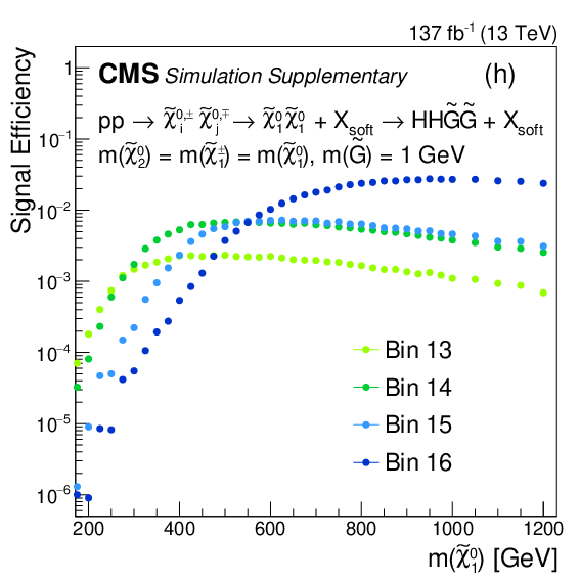
png pdf root |
Additional Figure 3-h:
Efficiency by signal region for the TChiHH-G model, $\tilde{\chi}^0_1 \tilde{\chi}^0_1 \to \mathrm{H} \mathrm{H} \tilde{\mathrm{G}} \tilde{\mathrm{G}} $. In this plot are shown bins 13-16. The data within the plot are given, in increasing order of bin number, by colors ranging from light green to blue. The SR indexing is given in Tables 4 and 5 of the paper. The denominator for the efficiency calculation includes only $\mathrm{H} \to \mathrm{b} \mathrm{\bar{b}} $ decays (for all SRs). |
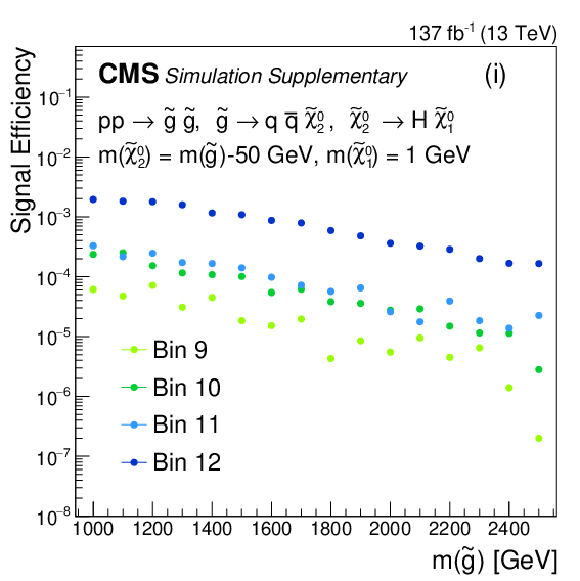
png pdf root |
Additional Figure 3-i:
Efficiency by signal region for the T5HH model, ${\mathrm{\widetilde{g}}} {\mathrm{\widetilde{g}}} \to \mathrm{q} \mathrm{\bar{q}} \mathrm{H} \mathrm{H} \tilde{\chi}^0_1 \tilde{\chi}^0_1 $. In this plot are shown bins 9-12. The data within the plot are given, in increasing order of bin number, by colors ranging from light green to blue. The SR indexing is given in Tables 4 and 5 of the paper. |

png pdf root |
Additional Figure 3-j:
Efficiency by signal region for the T5HH model, ${\mathrm{\widetilde{g}}} {\mathrm{\widetilde{g}}} \to \mathrm{q} \mathrm{\bar{q}} \mathrm{H} \mathrm{H} \tilde{\chi}^0_1 \tilde{\chi}^0_1 $. In this plot are shown bins 13-16. The data within the plot are given, in increasing order of bin number, by colors ranging from light green to blue. The SR indexing is given in Tables 4 and 5 of the paper. |
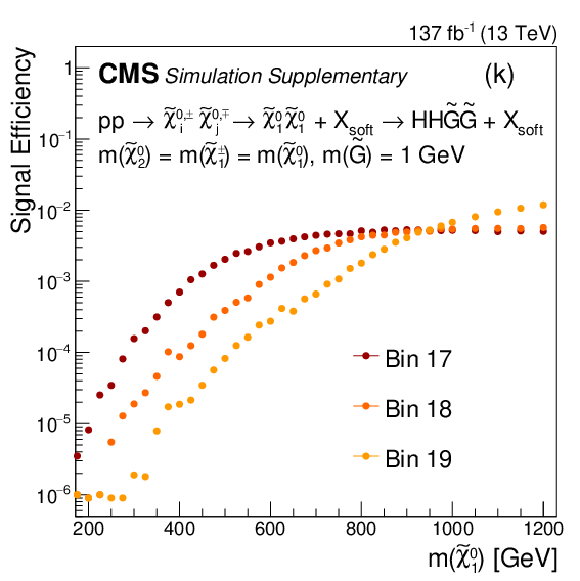
png pdf root |
Additional Figure 3-k:
Efficiency by signal region for the TChiHH-G model, $\tilde{\chi}^0_1 \tilde{\chi}^0_1 \to \mathrm{H} \mathrm{H} \tilde{\mathrm{G}} \tilde{\mathrm{G}} $. In this plot are shown bins 17-19. The data within the plot are given, in increasing order of bin number, by colors ranging from red to light orange. The SR indexing is given in Tables 4 and 5 of the paper. The denominator for the efficiency calculation includes only $\mathrm{H} \to \mathrm{b} \mathrm{\bar{b}} $ decays (for all SRs). |
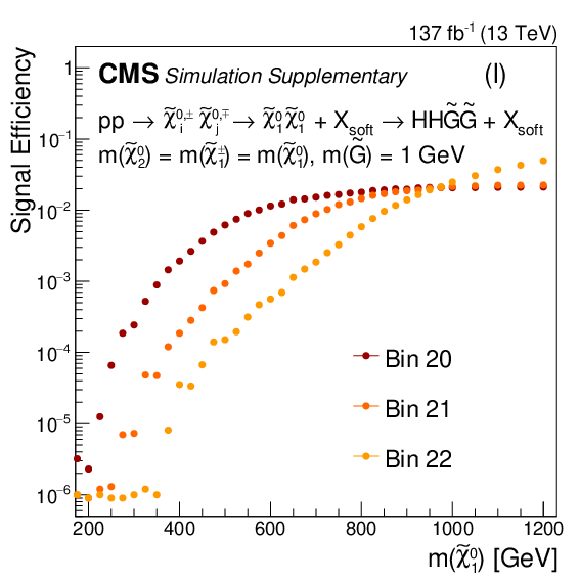
png pdf root |
Additional Figure 3-l:
Efficiency by signal region for the TChiHH-G model, $\tilde{\chi}^0_1 \tilde{\chi}^0_1 \to \mathrm{H} \mathrm{H} \tilde{\mathrm{G}} \tilde{\mathrm{G}} $. In this plot are shown bins 20-22. The data within the plot are given, in increasing order of bin number, by colors ranging from red to light orange. The SR indexing is given in Tables 4 and 5 of the paper. The denominator for the efficiency calculation includes only $\mathrm{H} \to \mathrm{b} \mathrm{\bar{b}} $ decays (for all SRs). |

png pdf root |
Additional Figure 3-m:
Efficiency by signal region for the T5HH model, ${\mathrm{\widetilde{g}}} {\mathrm{\widetilde{g}}} \to \mathrm{q} \mathrm{\bar{q}} \mathrm{H} \mathrm{H} \tilde{\chi}^0_1 \tilde{\chi}^0_1 $. In this plot are shown bins 17-19. The data within the plot are given, in increasing order of bin number, by colors ranging from red to light orange. The SR indexing is given in Tables 4 and 5 of the paper. |
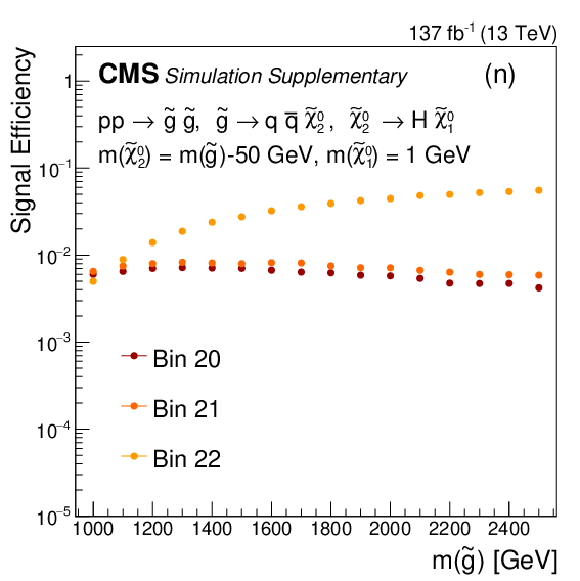
png pdf root |
Additional Figure 3-n:
Efficiency by signal region for the T5HH model, ${\mathrm{\widetilde{g}}} {\mathrm{\widetilde{g}}} \to \mathrm{q} \mathrm{\bar{q}} \mathrm{H} \mathrm{H} \tilde{\chi}^0_1 \tilde{\chi}^0_1 $. In this plot are shown bins 20-22. The data within the plot are given, in increasing order of bin number, by colors ranging from red to light orange. The SR indexing is given in Tables 4 and 5 of the paper. |
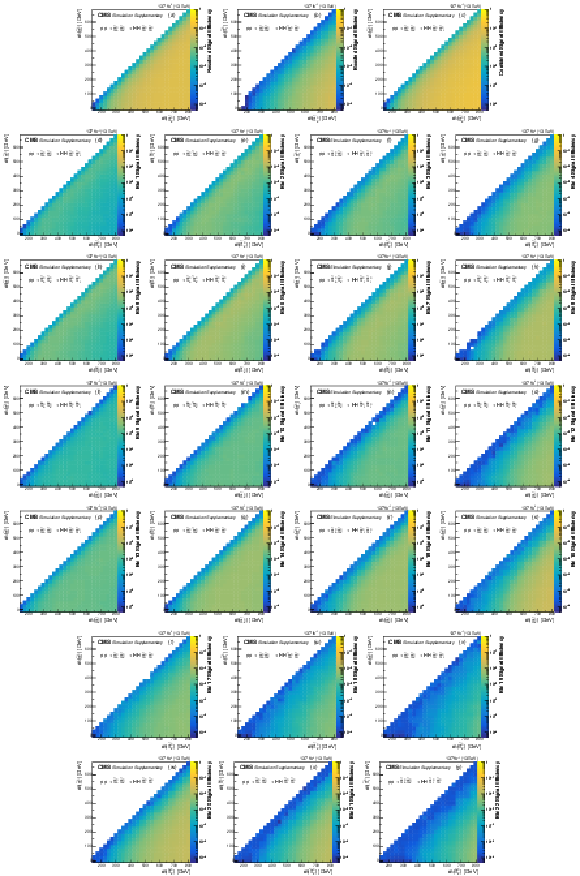
png pdf |
Additional Figure 4:
Efficiency for the TChiHH model, $\tilde{\chi}_2^0 \tilde{\chi}_2^0 \to \mathrm{H} \mathrm{H} \tilde{\chi}^0_1 \tilde{\chi}^0_1 $: (a) resolved SRs, (b) boosted SRs, (c) all SRs, and (d-y) SR 1-22. The SR indexing is given in Tables 4 and 5 of the paper. The denominator for the efficiency calculation includes only $\mathrm{H} \to \mathrm{b} \mathrm{\bar{b}} $ decays (for all SRs). Overlapping events between the two signatures have been removed from the boosted SRs. |

png pdf root |
Additional Figure 4-a:
Efficiency for the TChiHH model, $\tilde{\chi}_2^0 \tilde{\chi}_2^0 \to \mathrm{H} \mathrm{H} \tilde{\chi}^0_1 \tilde{\chi}^0_1 $: resolved SRs. boosted SRs. The denominator for the efficiency calculation includes only $\mathrm{H} \to \mathrm{b} \mathrm{\bar{b}} $ decays. |
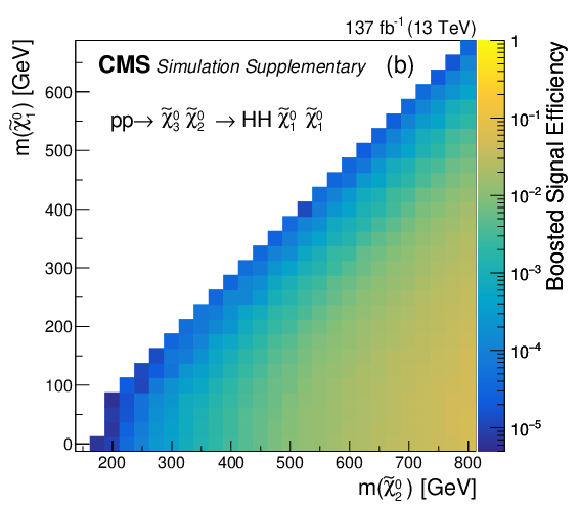
png pdf root |
Additional Figure 4-b:
Efficiency for the TChiHH model, $\tilde{\chi}_2^0 \tilde{\chi}_2^0 \to \mathrm{H} \mathrm{H} \tilde{\chi}^0_1 \tilde{\chi}^0_1 $: boosted SRs. The denominator for the efficiency calculation includes only $\mathrm{H} \to \mathrm{b} \mathrm{\bar{b}} $ decays. |
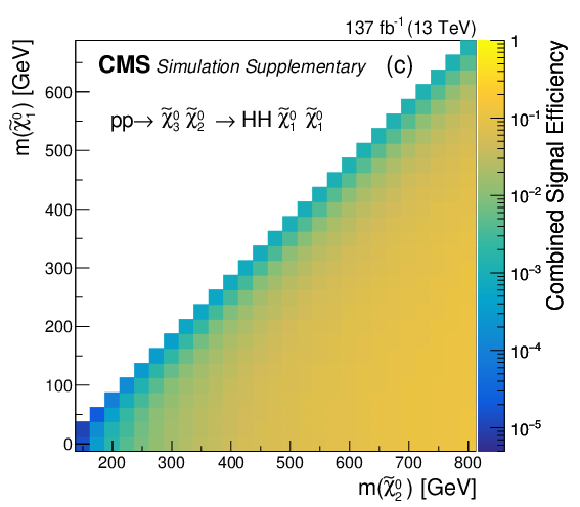
png pdf root |
Additional Figure 4-c:
Efficiency for the TChiHH model, $\tilde{\chi}_2^0 \tilde{\chi}_2^0 \to \mathrm{H} \mathrm{H} \tilde{\chi}^0_1 \tilde{\chi}^0_1 $: all SRs. The denominator for the efficiency calculation includes only $\mathrm{H} \to \mathrm{b} \mathrm{\bar{b}} $ decays. |

png pdf root |
Additional Figure 4-d:
Efficiency for the TChiHH model, $\tilde{\chi}_2^0 \tilde{\chi}_2^0 \to \mathrm{H} \mathrm{H} \tilde{\chi}^0_1 \tilde{\chi}^0_1 $: SR 1. The denominator for the efficiency calculation includes only $\mathrm{H} \to \mathrm{b} \mathrm{\bar{b}} $ decays. |
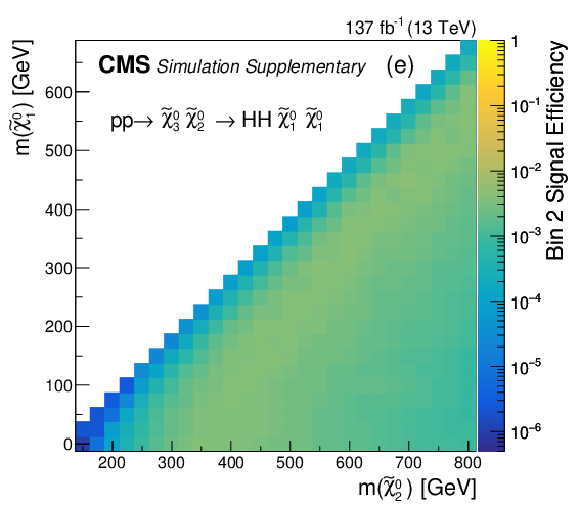
png pdf root |
Additional Figure 4-e:
Efficiency for the TChiHH model, $\tilde{\chi}_2^0 \tilde{\chi}_2^0 \to \mathrm{H} \mathrm{H} \tilde{\chi}^0_1 \tilde{\chi}^0_1 $: SR 2. The denominator for the efficiency calculation includes only $\mathrm{H} \to \mathrm{b} \mathrm{\bar{b}} $ decays. |

png pdf root |
Additional Figure 4-f:
Efficiency for the TChiHH model, $\tilde{\chi}_2^0 \tilde{\chi}_2^0 \to \mathrm{H} \mathrm{H} \tilde{\chi}^0_1 \tilde{\chi}^0_1 $: SR 3. The denominator for the efficiency calculation includes only $\mathrm{H} \to \mathrm{b} \mathrm{\bar{b}} $ decays. |
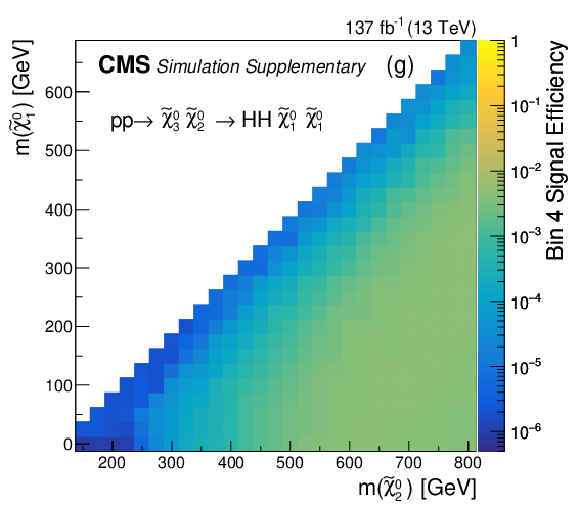
png pdf root |
Additional Figure 4-g:
Efficiency for the TChiHH model, $\tilde{\chi}_2^0 \tilde{\chi}_2^0 \to \mathrm{H} \mathrm{H} \tilde{\chi}^0_1 \tilde{\chi}^0_1 $: SR 4. The denominator for the efficiency calculation includes only $\mathrm{H} \to \mathrm{b} \mathrm{\bar{b}} $ decays. |
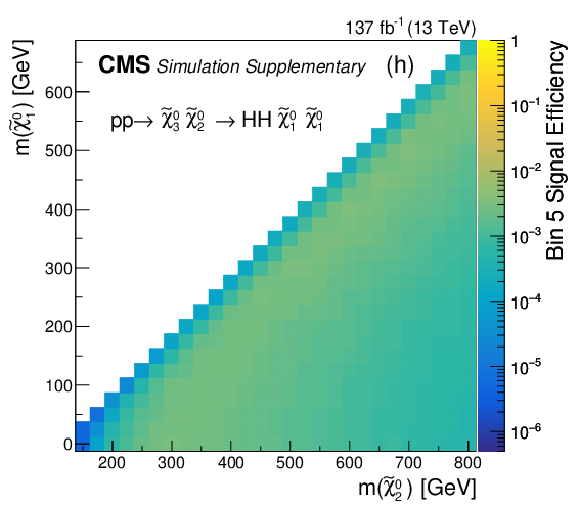
png pdf root |
Additional Figure 4-h:
Efficiency for the TChiHH model, $\tilde{\chi}_2^0 \tilde{\chi}_2^0 \to \mathrm{H} \mathrm{H} \tilde{\chi}^0_1 \tilde{\chi}^0_1 $: SR 5. The denominator for the efficiency calculation includes only $\mathrm{H} \to \mathrm{b} \mathrm{\bar{b}} $ decays. |
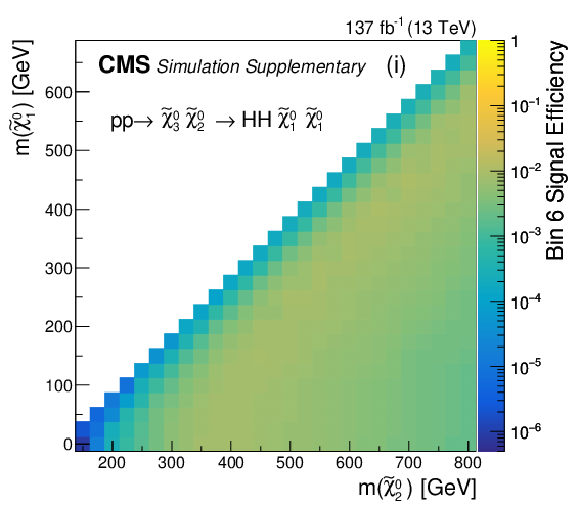
png pdf root |
Additional Figure 4-i:
Efficiency for the TChiHH model, $\tilde{\chi}_2^0 \tilde{\chi}_2^0 \to \mathrm{H} \mathrm{H} \tilde{\chi}^0_1 \tilde{\chi}^0_1 $: SR 6. The denominator for the efficiency calculation includes only $\mathrm{H} \to \mathrm{b} \mathrm{\bar{b}} $ decays. |
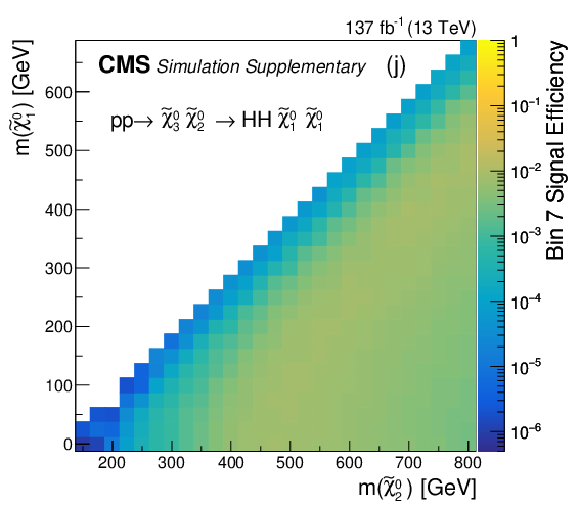
png pdf root |
Additional Figure 4-j:
Efficiency for the TChiHH model, $\tilde{\chi}_2^0 \tilde{\chi}_2^0 \to \mathrm{H} \mathrm{H} \tilde{\chi}^0_1 \tilde{\chi}^0_1 $: SR 7. The denominator for the efficiency calculation includes only $\mathrm{H} \to \mathrm{b} \mathrm{\bar{b}} $ decays. |

png pdf root |
Additional Figure 4-k:
Efficiency for the TChiHH model, $\tilde{\chi}_2^0 \tilde{\chi}_2^0 \to \mathrm{H} \mathrm{H} \tilde{\chi}^0_1 \tilde{\chi}^0_1 $: SR 8. The denominator for the efficiency calculation includes only $\mathrm{H} \to \mathrm{b} \mathrm{\bar{b}} $ decays. |
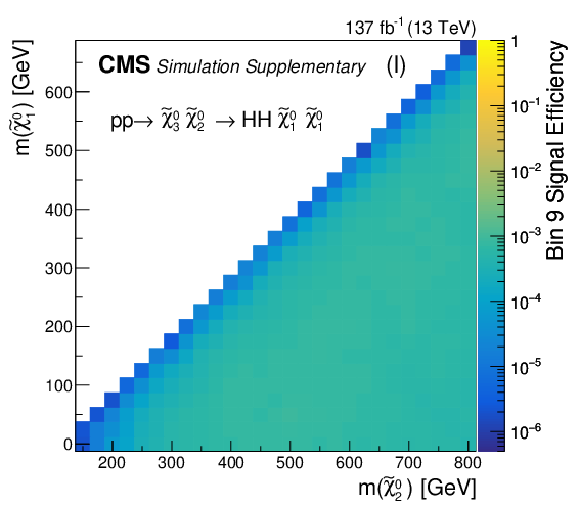
png pdf root |
Additional Figure 4-l:
Efficiency for the TChiHH model, $\tilde{\chi}_2^0 \tilde{\chi}_2^0 \to \mathrm{H} \mathrm{H} \tilde{\chi}^0_1 \tilde{\chi}^0_1 $: SR 9. The denominator for the efficiency calculation includes only $\mathrm{H} \to \mathrm{b} \mathrm{\bar{b}} $ decays. |

png pdf root |
Additional Figure 4-m:
Efficiency for the TChiHH model, $\tilde{\chi}_2^0 \tilde{\chi}_2^0 \to \mathrm{H} \mathrm{H} \tilde{\chi}^0_1 \tilde{\chi}^0_1 $: SR 10. The denominator for the efficiency calculation includes only $\mathrm{H} \to \mathrm{b} \mathrm{\bar{b}} $ decays. |
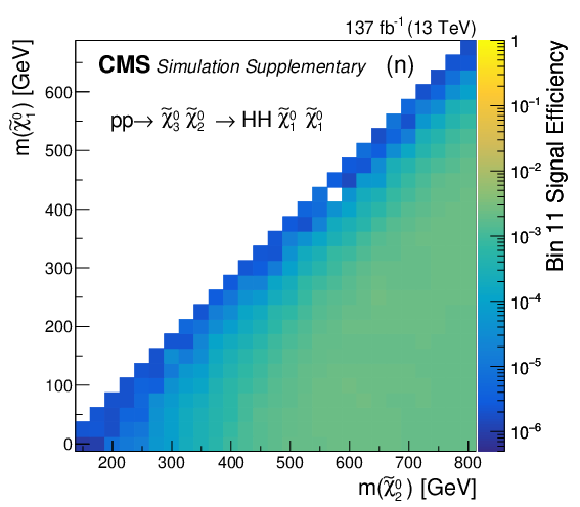
png pdf root |
Additional Figure 4-n:
Efficiency for the TChiHH model, $\tilde{\chi}_2^0 \tilde{\chi}_2^0 \to \mathrm{H} \mathrm{H} \tilde{\chi}^0_1 \tilde{\chi}^0_1 $: SR 11. The denominator for the efficiency calculation includes only $\mathrm{H} \to \mathrm{b} \mathrm{\bar{b}} $ decays. |
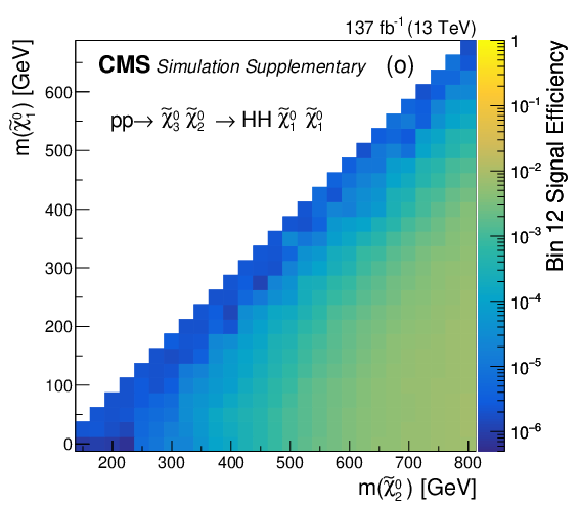
png pdf root |
Additional Figure 4-o:
Efficiency for the TChiHH model, $\tilde{\chi}_2^0 \tilde{\chi}_2^0 \to \mathrm{H} \mathrm{H} \tilde{\chi}^0_1 \tilde{\chi}^0_1 $: SR 12. The denominator for the efficiency calculation includes only $\mathrm{H} \to \mathrm{b} \mathrm{\bar{b}} $ decays. |

png pdf root |
Additional Figure 4-p:
Efficiency for the TChiHH model, $\tilde{\chi}_2^0 \tilde{\chi}_2^0 \to \mathrm{H} \mathrm{H} \tilde{\chi}^0_1 \tilde{\chi}^0_1 $: SR 13. The denominator for the efficiency calculation includes only $\mathrm{H} \to \mathrm{b} \mathrm{\bar{b}} $ decays. |
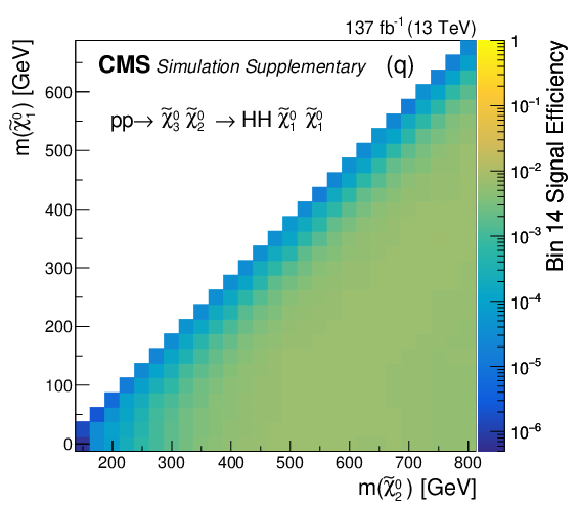
png pdf root |
Additional Figure 4-q:
Efficiency for the TChiHH model, $\tilde{\chi}_2^0 \tilde{\chi}_2^0 \to \mathrm{H} \mathrm{H} \tilde{\chi}^0_1 \tilde{\chi}^0_1 $: SR 14. The denominator for the efficiency calculation includes only $\mathrm{H} \to \mathrm{b} \mathrm{\bar{b}} $ decays. |

png pdf root |
Additional Figure 4-r:
Efficiency for the TChiHH model, $\tilde{\chi}_2^0 \tilde{\chi}_2^0 \to \mathrm{H} \mathrm{H} \tilde{\chi}^0_1 \tilde{\chi}^0_1 $: SR 15. The denominator for the efficiency calculation includes only $\mathrm{H} \to \mathrm{b} \mathrm{\bar{b}} $ decays. |

png pdf root |
Additional Figure 4-s:
Efficiency for the TChiHH model, $\tilde{\chi}_2^0 \tilde{\chi}_2^0 \to \mathrm{H} \mathrm{H} \tilde{\chi}^0_1 \tilde{\chi}^0_1 $: SR 16. The denominator for the efficiency calculation includes only $\mathrm{H} \to \mathrm{b} \mathrm{\bar{b}} $ decays. |

png pdf root |
Additional Figure 4-t:
Efficiency for the TChiHH model, $\tilde{\chi}_2^0 \tilde{\chi}_2^0 \to \mathrm{H} \mathrm{H} \tilde{\chi}^0_1 \tilde{\chi}^0_1 $: SR 17. The denominator for the efficiency calculation includes only $\mathrm{H} \to \mathrm{b} \mathrm{\bar{b}} $ decays. |

png pdf root |
Additional Figure 4-u:
Efficiency for the TChiHH model, $\tilde{\chi}_2^0 \tilde{\chi}_2^0 \to \mathrm{H} \mathrm{H} \tilde{\chi}^0_1 \tilde{\chi}^0_1 $: SR 18. The denominator for the efficiency calculation includes only $\mathrm{H} \to \mathrm{b} \mathrm{\bar{b}} $ decays. |

png pdf root |
Additional Figure 4-v:
Efficiency for the TChiHH model, $\tilde{\chi}_2^0 \tilde{\chi}_2^0 \to \mathrm{H} \mathrm{H} \tilde{\chi}^0_1 \tilde{\chi}^0_1 $: SR 19. The denominator for the efficiency calculation includes only $\mathrm{H} \to \mathrm{b} \mathrm{\bar{b}} $ decays. |
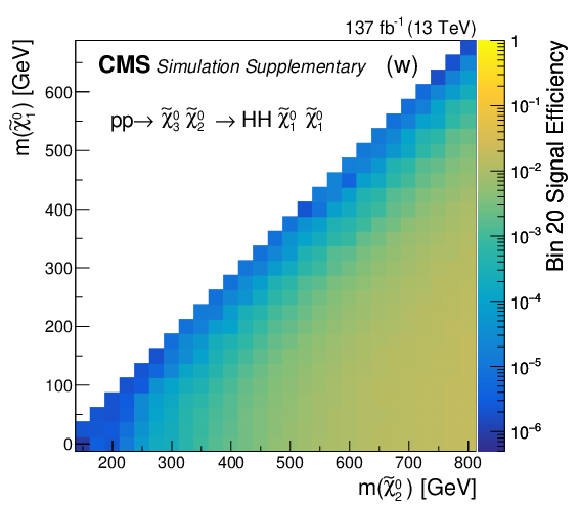
png pdf root |
Additional Figure 4-w:
Efficiency for the TChiHH model, $\tilde{\chi}_2^0 \tilde{\chi}_2^0 \to \mathrm{H} \mathrm{H} \tilde{\chi}^0_1 \tilde{\chi}^0_1 $: SR 20. The denominator for the efficiency calculation includes only $\mathrm{H} \to \mathrm{b} \mathrm{\bar{b}} $ decays. |

png pdf root |
Additional Figure 4-x:
Efficiency for the TChiHH model, $\tilde{\chi}_2^0 \tilde{\chi}_2^0 \to \mathrm{H} \mathrm{H} \tilde{\chi}^0_1 \tilde{\chi}^0_1 $: SR 21. The denominator for the efficiency calculation includes only $\mathrm{H} \to \mathrm{b} \mathrm{\bar{b}} $ decays. |
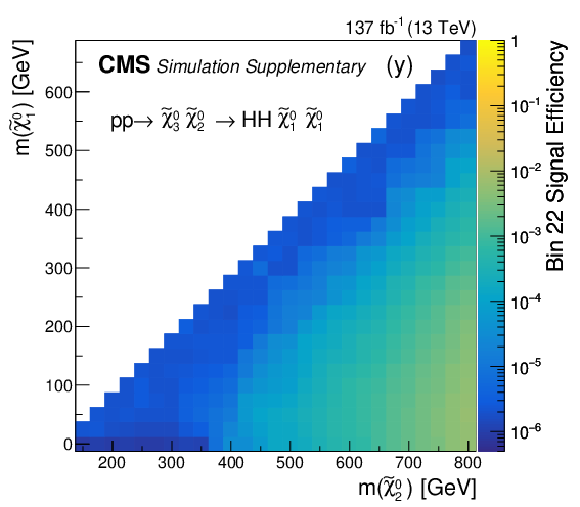
png pdf root |
Additional Figure 4-y:
Efficiency for the TChiHH model, $\tilde{\chi}_2^0 \tilde{\chi}_2^0 \to \mathrm{H} \mathrm{H} \tilde{\chi}^0_1 \tilde{\chi}^0_1 $: SR 22. The denominator for the efficiency calculation includes only $\mathrm{H} \to \mathrm{b} \mathrm{\bar{b}} $ decays. |
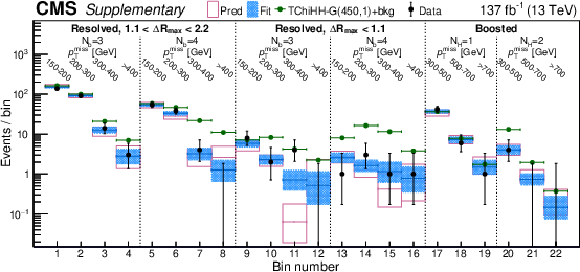
png pdf |
Additional Figure 5:
Observed and predicted yields in the search regions identified by the legend text. The black points with vertical error bars represent the observed yields, the magenta outline bands the background yields derived from the data sidebands with their total uncertainty, blue shaded bands the values determined by the background-only fit, and the green points with horizontal bars (indicating the bin width) the sum of the background yields derived from the data sidebands and the yields of the TChiHH-G(450,1) model with signal strength 1. |

png pdf |
Additional Figure 6:
(a) Covariance and (b) correlation matrices for the 22 search bins, ordered as in Tables 4 and 5 of the paper. |
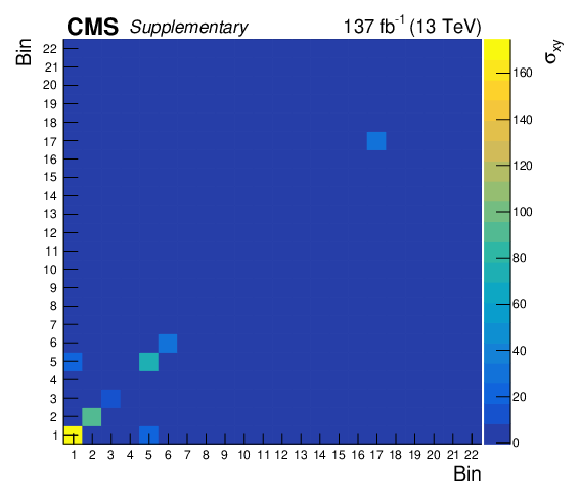
png pdf root |
Additional Figure 6-a:
Covariance matrix for the 22 search bins, ordered as in Tables 4 and 5 of the paper. |

png pdf root |
Additional Figure 6-b:
Correlation matrix for the 22 search bins, ordered as in Tables 4 and 5 of the paper. |

png pdf |
Additional Figure 7:
${{p_{\mathrm {T}}} ^\text {miss}}$ trigger efficiency (points) as a function of ${{p_{\mathrm {T}}} ^\text {miss}}$ for each year of data taking. The trigger threshold varied between 90 and 140 GeV, depending on the LHC instantaneous luminosity resulting in different efficiencies for each year. For large values of ${{p_{\mathrm {T}}} ^\text {miss}}$, the efficiency for all three years is unity. The solid (dashed) histogram gives the corresponding event count for the numerator (denominator) entering into the efficiency calculation. |
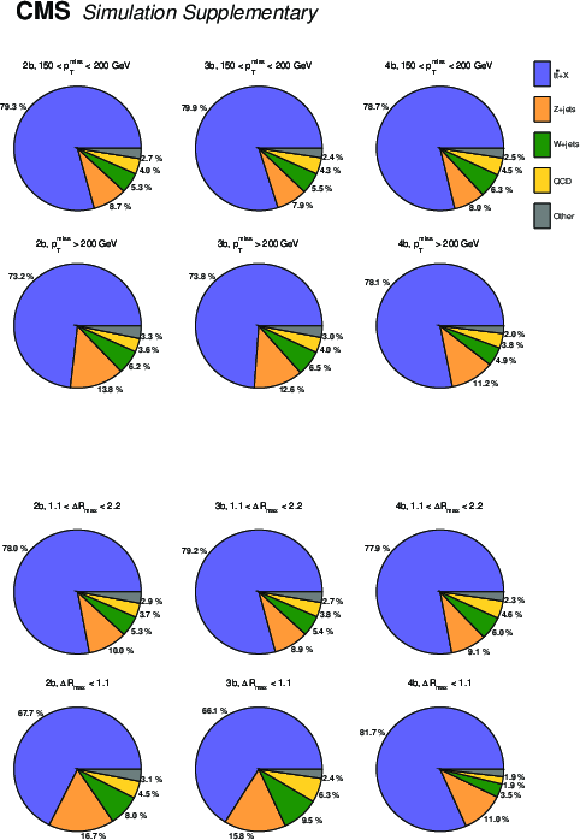
png pdf |
Additional Figure 8:
The background composition for different categories for the resolved topology. The columns correspond to 2b (left), 3b (center), and 4b (right). Each row has one selection in addition to the baseline selection, 150 $ < {{p_{\mathrm {T}}} ^\text {miss}} < $ 200 GeV (top row), $ {{p_{\mathrm {T}}} ^\text {miss}} > $ 200 GeV (second row), 1.1 $ < \Delta R_{\text {max}} < $ 2.2 (third row), and $\Delta R_{\text {max}} < $ 1.1 (bottom row). |
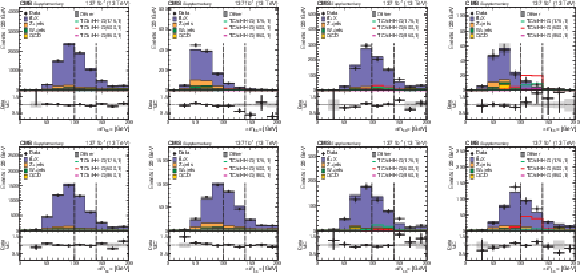
png pdf |
Additional Figure 9:
Distributions of $< m_{\mathrm{b} \mathrm{b}}> $ for data and simulation in various categories within the resolved signature baseline selection: (a) 2b and 1.1 $ < \Delta R_{\text {max}} < $ 2.2, (b) 2b and $\Delta R_{\text {max}} < $ 1.1, (c) 3-4b and 1.1 $ < \Delta R_{\text {max}} < $ 2.2, (d) 3-4b and $\Delta R_{\text {max}} < $ 1.1, (e) 2b and 150 $ < {{p_{\mathrm {T}}} ^\text {miss}} < $ 200 GeV, (f) 2b and $ {{p_{\mathrm {T}}} ^\text {miss}} > $ 200 GeV, (g) 3 and 4b $-$150 $ < {{p_{\mathrm {T}}} ^\text {miss}} < $ 200 GeV, and (h) 3-4b and $ {{p_{\mathrm {T}}} ^\text {miss}} > $ 200 GeV. |
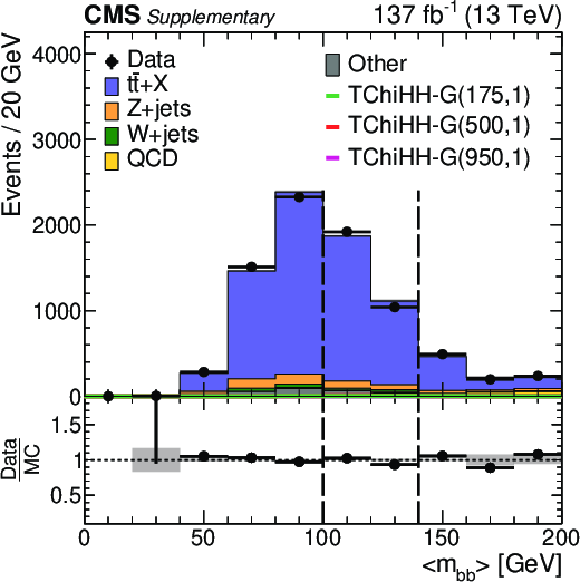
png pdf |
Additional Figure 9-a:
Distribution of $< m_{\mathrm{b} \mathrm{b}}> $ for data and simulation in the 2b and 1.1 $ < \Delta R_{\text {max}} < $ 2.2 category. |
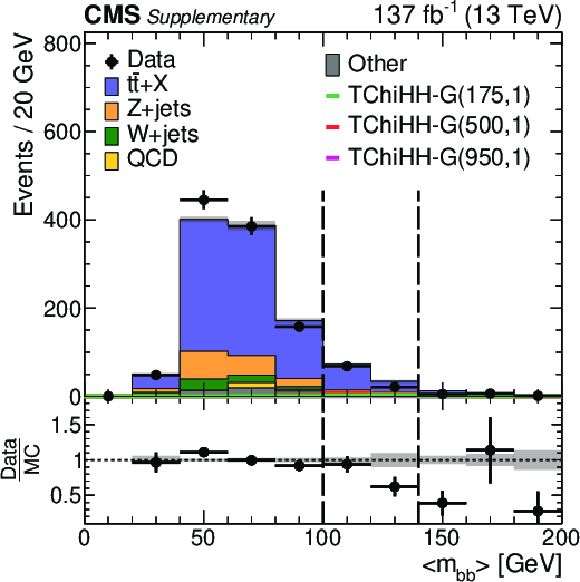
png pdf |
Additional Figure 9-b:
Distribution of $< m_{\mathrm{b} \mathrm{b}}> $ for data and simulation in the 2b and $\Delta R_{\text {max}} < $ 1.1 category. |

png pdf |
Additional Figure 9-c:
Distribution of $< m_{\mathrm{b} \mathrm{b}}> $ for data and simulation in the 3-4b and 1.1 $ < \Delta R_{\text {max}} < $ 2.2 category. |

png pdf |
Additional Figure 9-d:
Distribution of $< m_{\mathrm{b} \mathrm{b}}> $ for data and simulation in the 3-4b and $\Delta R_{\text {max}} < $ 1.1 category. |

png pdf |
Additional Figure 9-e:
Distribution of $< m_{\mathrm{b} \mathrm{b}}> $ for data and simulation in the 2b and 150 $ < {{p_{\mathrm {T}}} ^\text {miss}} < $ 200 GeV category. |
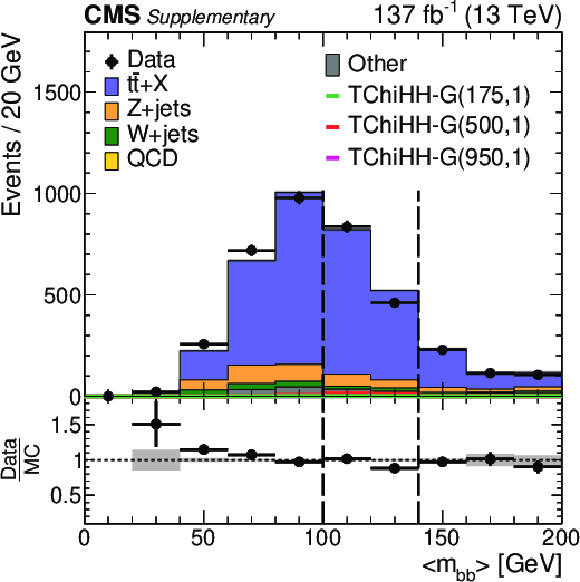
png pdf |
Additional Figure 9-f:
Distribution of $< m_{\mathrm{b} \mathrm{b}}> $ for data and simulation in the 2b and $ {{p_{\mathrm {T}}} ^\text {miss}} > $ 200 GeV category. |

png pdf |
Additional Figure 9-g:
Distribution of $< m_{\mathrm{b} \mathrm{b}}> $ for data and simulation in the 3 and 4b $-$150 $ < {{p_{\mathrm {T}}} ^\text {miss}} < $ 200 GeV category. |
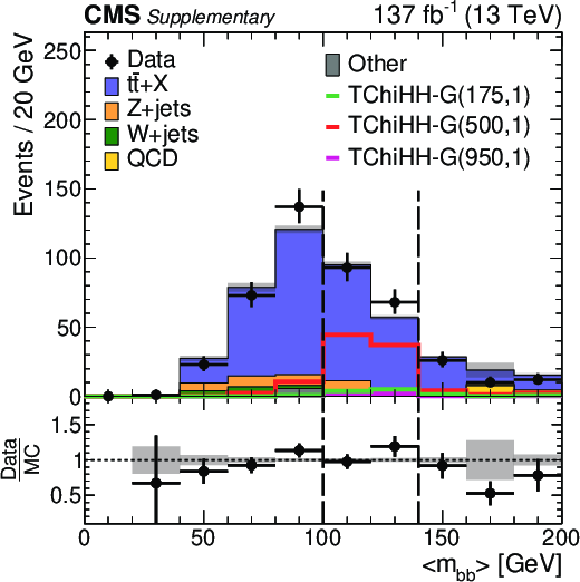
png pdf |
Additional Figure 9-h:
Distribution of $< m_{\mathrm{b} \mathrm{b}}> $ for data and simulation in the 3-4b and $ {{p_{\mathrm {T}}} ^\text {miss}} > $ 200 GeV category. |
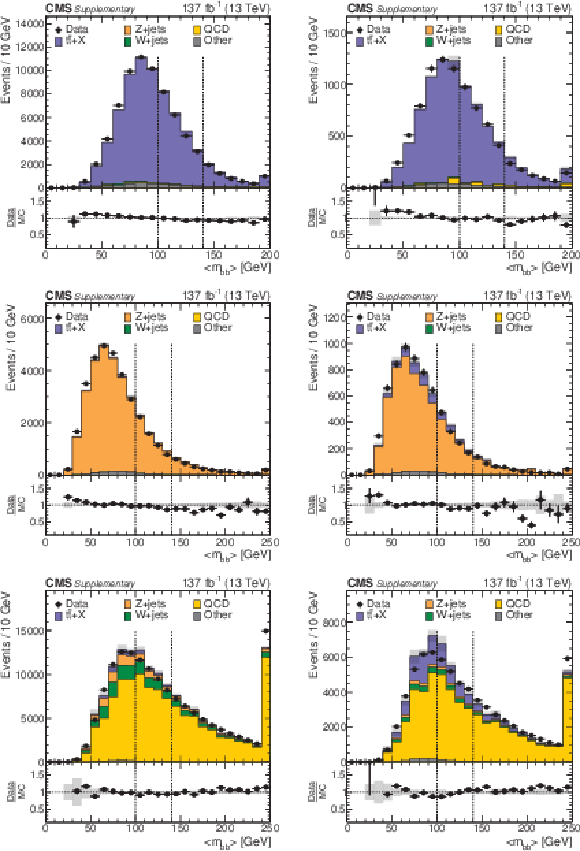
png pdf |
Additional Figure 10:
Distributions in $< m_{\mathrm{b} \mathrm{b}}> $ for data and simulated control samples of the resolved signature: (a, b) the 1-lepton control sample with $ {{p_{\mathrm {T}}} ^\text {miss}} > $ 75 GeV for the 2b and 3-4b categories respectively; (c, d) the 2-lepton control sample for the 0b and 1b categories respectively; and (e, f) the low-$\Delta \phi $ control sample for the 0b and 1b categories respectively. |

png pdf |
Additional Figure 10-a:
Distributions in $< m_{\mathrm{b} \mathrm{b}}> $ for data and simulated control samples of the resolved signature: the 1-lepton control sample with $ {{p_{\mathrm {T}}} ^\text {miss}} > $ 75 GeV for the 2b category. |

png pdf |
Additional Figure 10-b:
Distributions in $< m_{\mathrm{b} \mathrm{b}}> $ for data and simulated control samples of the resolved signature: |
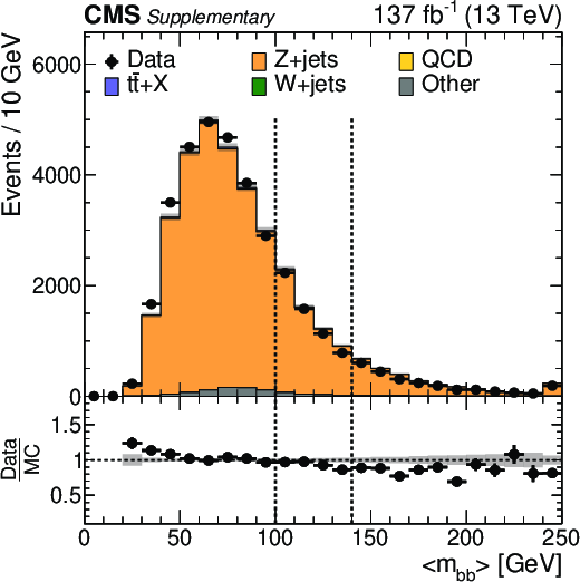
png pdf |
Additional Figure 10-c:
Distributions in $< m_{\mathrm{b} \mathrm{b}}> $ for data and simulated control samples of the resolved signature: the 2-lepton control sample for the 0b category. |

png pdf |
Additional Figure 10-d:
Distributions in $< m_{\mathrm{b} \mathrm{b}}> $ for data and simulated control samples of the resolved signature: the 2-lepton control sample for the 1b category. |
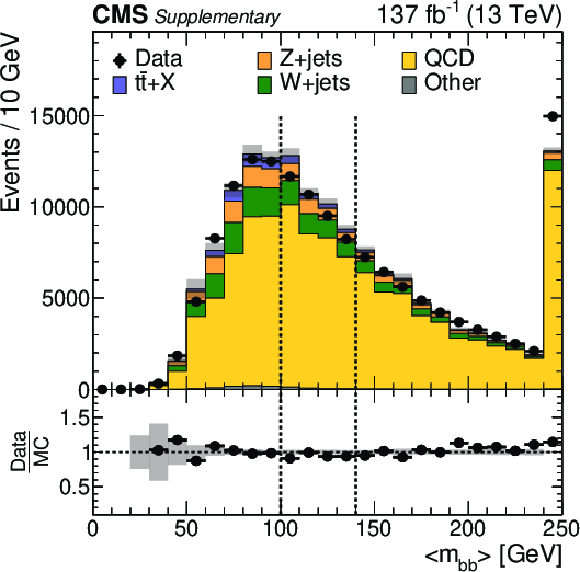
png pdf |
Additional Figure 10-e:
Distributions in $< m_{\mathrm{b} \mathrm{b}}> $ for data and simulated control samples of the resolved signature: the low-$\Delta \phi $ control sample for the 0b category. |
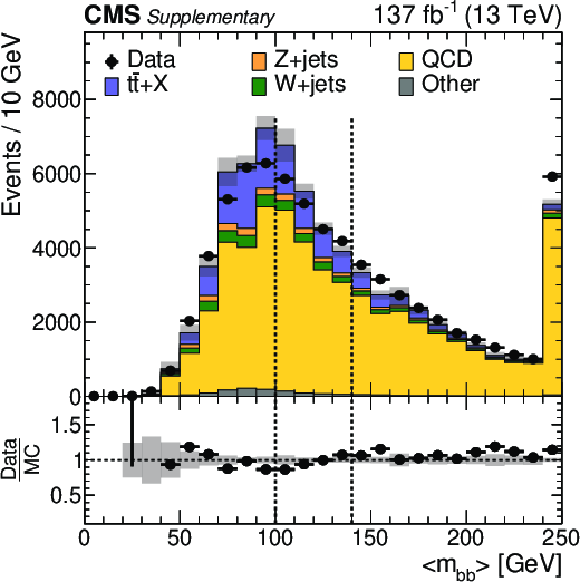
png pdf |
Additional Figure 10-f:
Distributions in $< m_{\mathrm{b} \mathrm{b}}> $ for data and simulated control samples of the resolved signature: the low-$\Delta \phi $ control sample for the 1b category. |

png pdf |
Additional Figure 11:
Comparison of the $< m_{\mathrm{b} \mathrm{b}}> $ shape among the $N_{\mathrm{b}}=$ 2, 3, and 4 regions for the background simulation. The histograms are normalized to a common area. The regions CSR and SR are defined to be within the H mass window 100 $ < \, < m_{\mathrm{b} \mathrm{b}}> \, < $ 140 GeV, and CSB and SB are outside of the H mass window, 0 $ < < m_{\mathrm{b} \mathrm{b}}> < $ 100 GeV or 140 $ < \, < m_{\mathrm{b} \mathrm{b}}> \, < $ 200 GeV. |

png pdf |
Additional Figure 12:
Comparison of the value of $\kappa = (N_\text {SR}/N_\text {SB})/(N_\text {CSR}/N_\text {CSB})$, for the resolved signature, between SM simulation and data for the 1-lepton control sample (a), the 2-lepton control sample (b), and the low-$\Delta \phi $ control sample (c). The values of $\Delta _\kappa $ refer to the difference between the value of $\kappa $ in data and simulation. The symbol $\sigma _\text {stat}$ refers to the statistical uncertainty of the value of $\kappa $ measured in data relative to unity. |

png pdf |
Additional Figure 12-a:
Comparison of the value of $\kappa = (N_\text {SR}/N_\text {SB})/(N_\text {CSR}/N_\text {CSB})$, for the resolved signature, between SM simulation and data for the 1-lepton control sample. The values of $\Delta _\kappa $ refer to the difference between the value of $\kappa $ in data and simulation. The symbol $\sigma _\text {stat}$ refers to the statistical uncertainty of the value of $\kappa $ measured in data relative to unity. |

png pdf |
Additional Figure 12-b:
Comparison of the value of $\kappa = (N_\text {SR}/N_\text {SB})/(N_\text {CSR}/N_\text {CSB})$, for the resolved signature, between SM simulation and data for the 2-lepton control sample. The values of $\Delta _\kappa $ refer to the difference between the value of $\kappa $ in data and simulation. The symbol $\sigma _\text {stat}$ refers to the statistical uncertainty of the value of $\kappa $ measured in data relative to unity. |

png pdf |
Additional Figure 12-c:
Comparison of the value of $\kappa = (N_\text {SR}/N_\text {SB})/(N_\text {CSR}/N_\text {CSB})$, for the resolved signature, between SM simulation and data for the low-$\Delta \phi $ control sample. The values of $\Delta _\kappa $ refer to the difference between the value of $\kappa $ in data and simulation. The symbol $\sigma _\text {stat}$ refers to the statistical uncertainty of the value of $\kappa $ measured in data relative to unity. |

png pdf |
Additional Figure 13:
The background composition in each of the six analysis regions for the boosted topology, integrated over ${{p_{\mathrm {T}}} ^\text {miss}}$, for $N_{\mathrm {H}}= $ 2 (top), $N_{\mathrm {H}} = $ 1 (second row), and $N_{\mathrm {H}}= $ 0 (third row). The left column shows the three regions with jets in the mass window (95-145 GeV), (C)SR, while the right column shows the three regions in the mass sideband (60-95 GeV) and (145-260 GeV), (C)SB. The bottom left is for the "0H+b" region. |

png pdf |
Additional Figure 14:
Distributions in ${{p_{\mathrm {T}}} ^\text {miss}}$ for the (a) $N_{\mathrm {H}} = $ 1 and (b) $N_{\mathrm {H}}= $ 2 signal regions of the boosted phase space, from the simulation (filled histograms). Two signal points, one each for the TChiHH-G and T5HH signal samples, are shown by the red dotted and solid lines. |
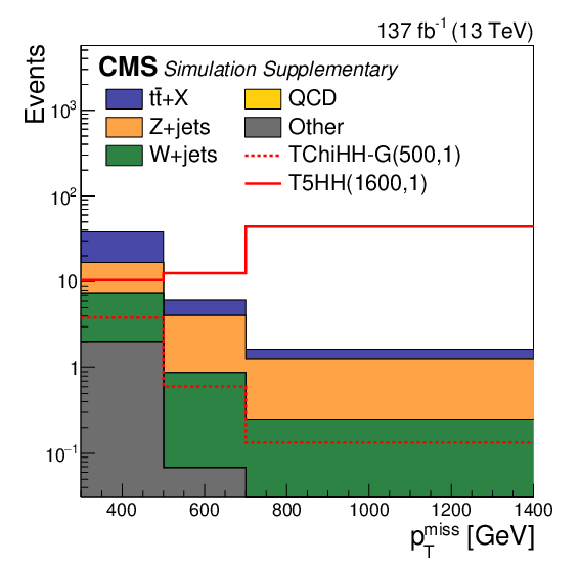
png pdf |
Additional Figure 14-a:
Distributions in ${{p_{\mathrm {T}}} ^\text {miss}}$ for the $N_{\mathrm {H}} = $ 1 signal region of the boosted phase space, from the simulation (filled histograms). Two signal points, one each for the TChiHH-G and T5HH signal samples, are shown by the red dotted and solid lines. |

png pdf |
Additional Figure 14-b:
Distributions in ${{p_{\mathrm {T}}} ^\text {miss}}$ for the $N_{\mathrm {H}}= $ 2 signal region of the boosted phase space, from the simulation (filled histograms). Two signal points, one each for the TChiHH-G and T5HH signal samples, are shown by the red dotted and solid lines. |

png pdf |
Additional Figure 15:
Distributions for the (a, c, and e) leading- and (b, d, and f) subleading-$ {p_{\mathrm {T}}}$ jet, in the most pertinent variables for the boosted signature. The baseline requirements are applied, except for those on the variable shown. The variables are (a, b) $ {p_{\mathrm {T}}}$, (c, d) $D_{{\mathrm{b} \mathrm{b}}}$, and (e, f) $m_{J}$. The SM backgrounds from simulation are scaled by 86% to match the data integral. Two signal points, a mass point for the TChiHH-G and one for the T5HH signal samples, are shown. The lower panel in each plot shows the ratio of observed to (scaled) simulated yields. |

png pdf |
Additional Figure 15-a:
Distribution of $ {p_{\mathrm {T}}}$ for the leading-$ {p_{\mathrm {T}}}$ jet. The baseline requirements are applied, except for those on the variable shown. The SM backgrounds from simulation are scaled by 86% to match the data integral. Two signal points, a mass point for the TChiHH-G and one for the T5HH signal samples, are shown. The lower panel shows the ratio of observed to (scaled) simulated yields. |

png pdf |
Additional Figure 15-b:
Distribution of $ {p_{\mathrm {T}}}$ for the subleading-$ {p_{\mathrm {T}}}$ jet. The baseline requirements are applied, except for those on the variable shown. The SM backgrounds from simulation are scaled by 86% to match the data integral. Two signal points, a mass point for the TChiHH-G and one for the T5HH signal samples, are shown. The lower panel shows the ratio of observed to (scaled) simulated yields. |

png pdf |
Additional Figure 15-c:
Distribution of $D_{{\mathrm{b} \mathrm{b}}}$ for the leading-$ {p_{\mathrm {T}}}$ jet. The baseline requirements are applied, except for those on the variable shown. The SM backgrounds from simulation are scaled by 86% to match the data integral. Two signal points, a mass point for the TChiHH-G and one for the T5HH signal samples, are shown. The lower panel shows the ratio of observed to (scaled) simulated yields. |

png pdf |
Additional Figure 15-d:
Distribution of $D_{{\mathrm{b} \mathrm{b}}}$ for the subleading-$ {p_{\mathrm {T}}}$ jet. The baseline requirements are applied, except for those on the variable shown. The SM backgrounds from simulation are scaled by 86% to match the data integral. Two signal points, a mass point for the TChiHH-G and one for the T5HH signal samples, are shown. The lower panel shows the ratio of observed to (scaled) simulated yields. |

png pdf |
Additional Figure 15-e:
Distribution of $m_{J}$ for the leading-$ {p_{\mathrm {T}}}$ jet. The baseline requirements are applied, except for those on the variable shown. The SM backgrounds from simulation are scaled by 86% to match the data integral. Two signal points, a mass point for the TChiHH-G and one for the T5HH signal samples, are shown. The lower panel shows the ratio of observed to (scaled) simulated yields. |

png pdf |
Additional Figure 15-f:
Distribution of $m_{J}$ for the subleading-$ {p_{\mathrm {T}}}$ jet. The baseline requirements are applied, except for those on the variable shown. The SM backgrounds from simulation are scaled by 86% to match the data integral. Two signal points, a mass point for the TChiHH-G and one for the T5HH signal samples, are shown. The lower panel shows the ratio of observed to (scaled) simulated yields. |

png pdf |
Additional Figure 16:
The full background estimation method closure for the boosted topology for (a, c) $N_{\mathrm {H}} = $ 1 and (b, d) $N_{\mathrm {H}}= $ 2 signal regions, in both MC (a, b) and data (c, d). The error bars on the background prediction are statistical only. |

png pdf |
Additional Figure 16-a:
The full background estimation method closure for the boosted topology for $N_{\mathrm {H}} = $ 1 signal region, in MC. The error bars on the background prediction are statistical only. |

png pdf |
Additional Figure 16-b:
The full background estimation method closure for the boosted topology for $N_{\mathrm {H}} = $ 2 signal region, in MC. The error bars on the background prediction are statistical only. |

png pdf |
Additional Figure 16-c:
The full background estimation method closure for the boosted topology for $N_{\mathrm {H}} = $ 1 signal region, in data. The error bars on the background prediction are statistical only. |

png pdf |
Additional Figure 16-d:
The full background estimation method closure for the boosted topology for $N_{\mathrm {H}} = $ 2 signal region, in data. The error bars on the background prediction are statistical only. |
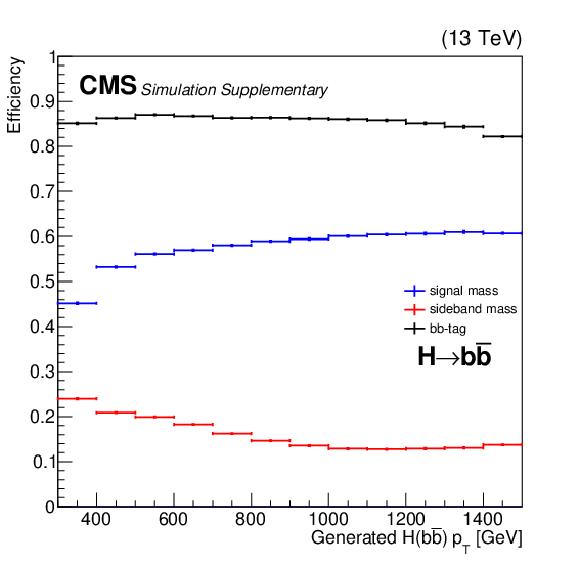
png pdf |
Additional Figure 17:
Efficiencies for Higgs-matched AK8 jets for $D_{ {\mathrm{b} \mathrm{b}}}$ (black) and the soft-drop mass algorithm (blue and red) for the boosted topology. The mass efficiency of the signal window (95-145 GeV) (blue) and the sideband (60-95 and 145-260 GeV) (red) are relative to the boosted baseline selection, except for the $m_{\mathrm {J}}$ requirement. The $D_{ {\mathrm{b} \mathrm{b}}}$ efficiency is for jets within the signal mass window. The sample considered for this efficiency is a combination of signal mass points in the simplified T5HH model. |
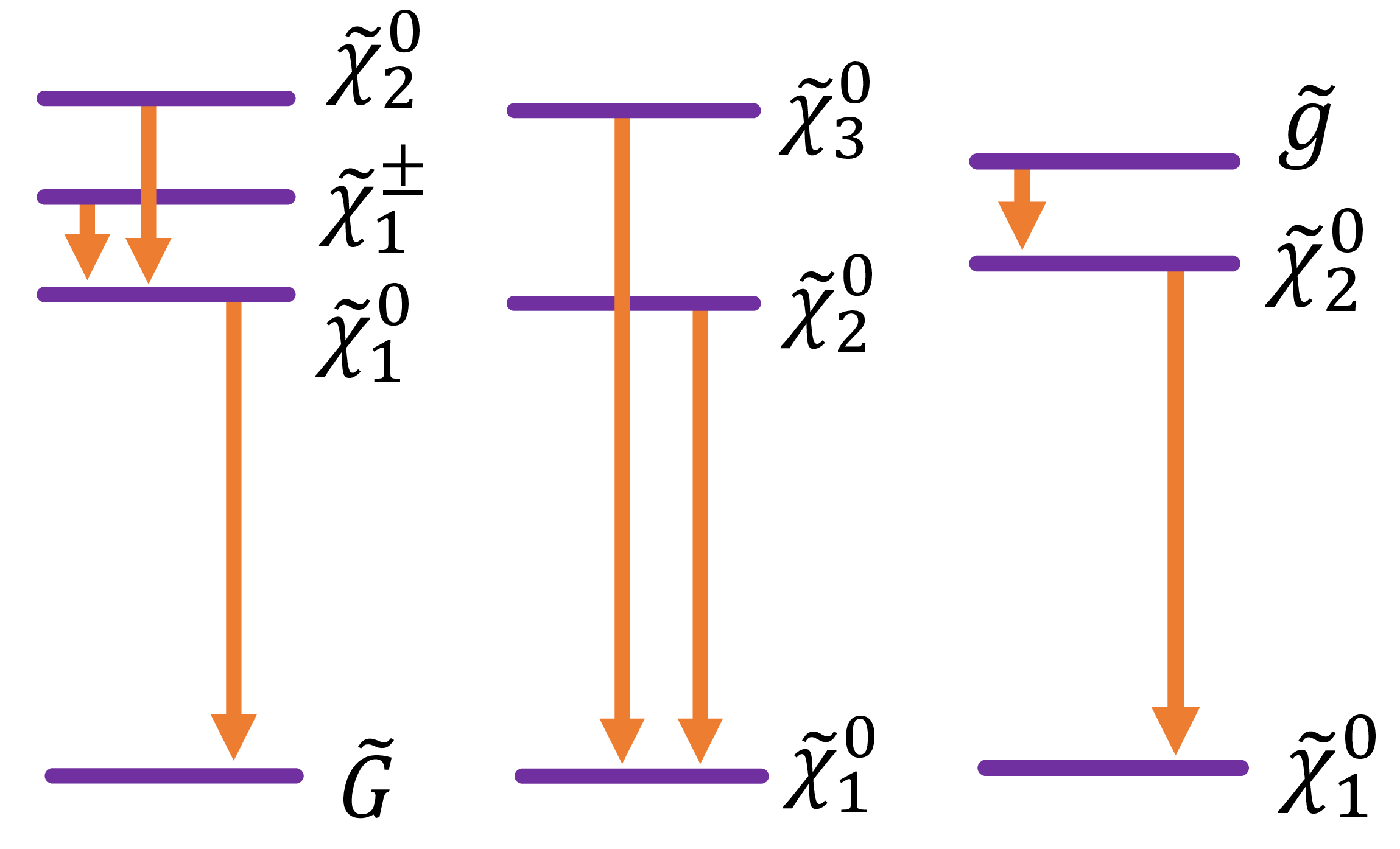
png pdf |
Additional Figure 18:
Mass hierarchy of the SUSY particles in the simplified SUSY models; (a) TChiHH-G, (b) TChiHH, (c) T5HH. |

png pdf |
Additional Figure 18-a:
Mass hierarchy of the SUSY particles in the simplified SUSY TChiHH-G model. |
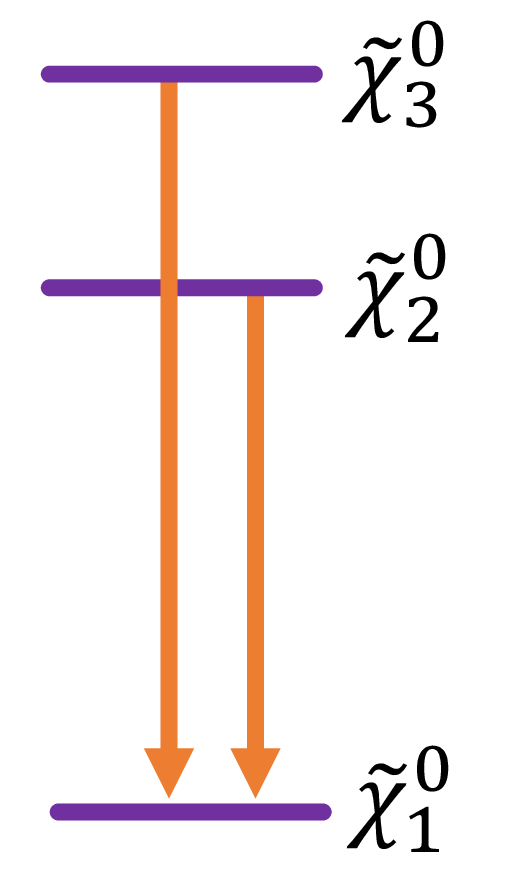
png pdf |
Additional Figure 18-b:
Mass hierarchy of the SUSY particles in the simplified SUSY TChiHH model. |
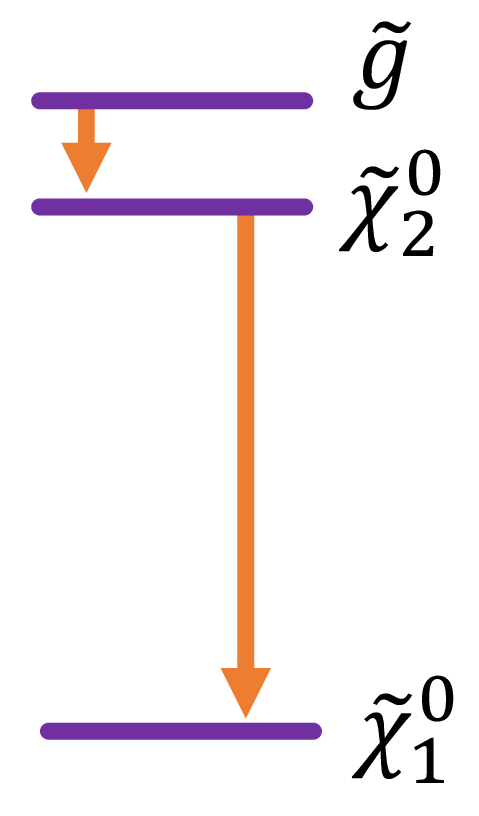
png pdf |
Additional Figure 18-c:
Mass hierarchy of the SUSY particles in the simplified SUSY T5HH model. |
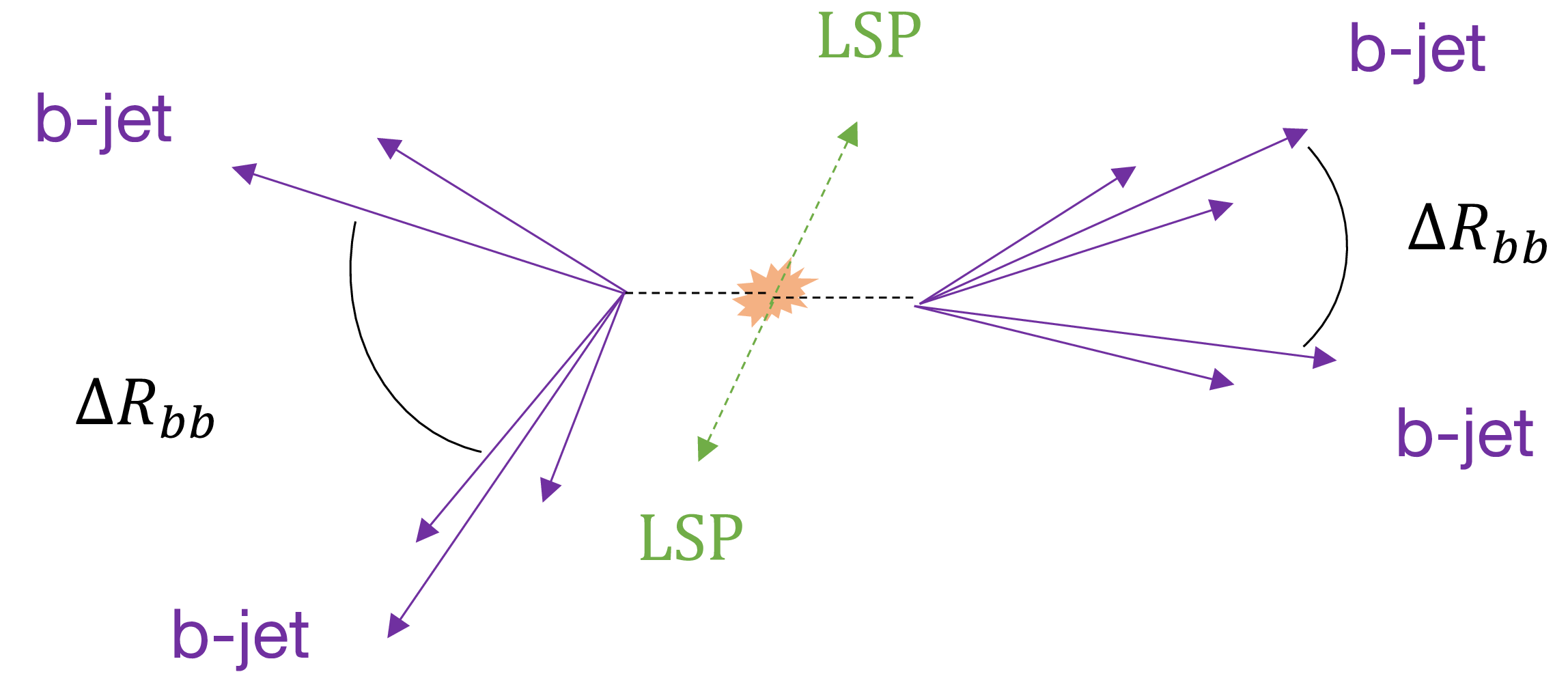
png pdf |
Additional Figure 19:
Signal event topology in an electroweak production scenario. |

png pdf |
Additional Figure 20:
Reconstruction of a Higgs boson as (a) two AK4 jets, and (b) one AK8 jet. |
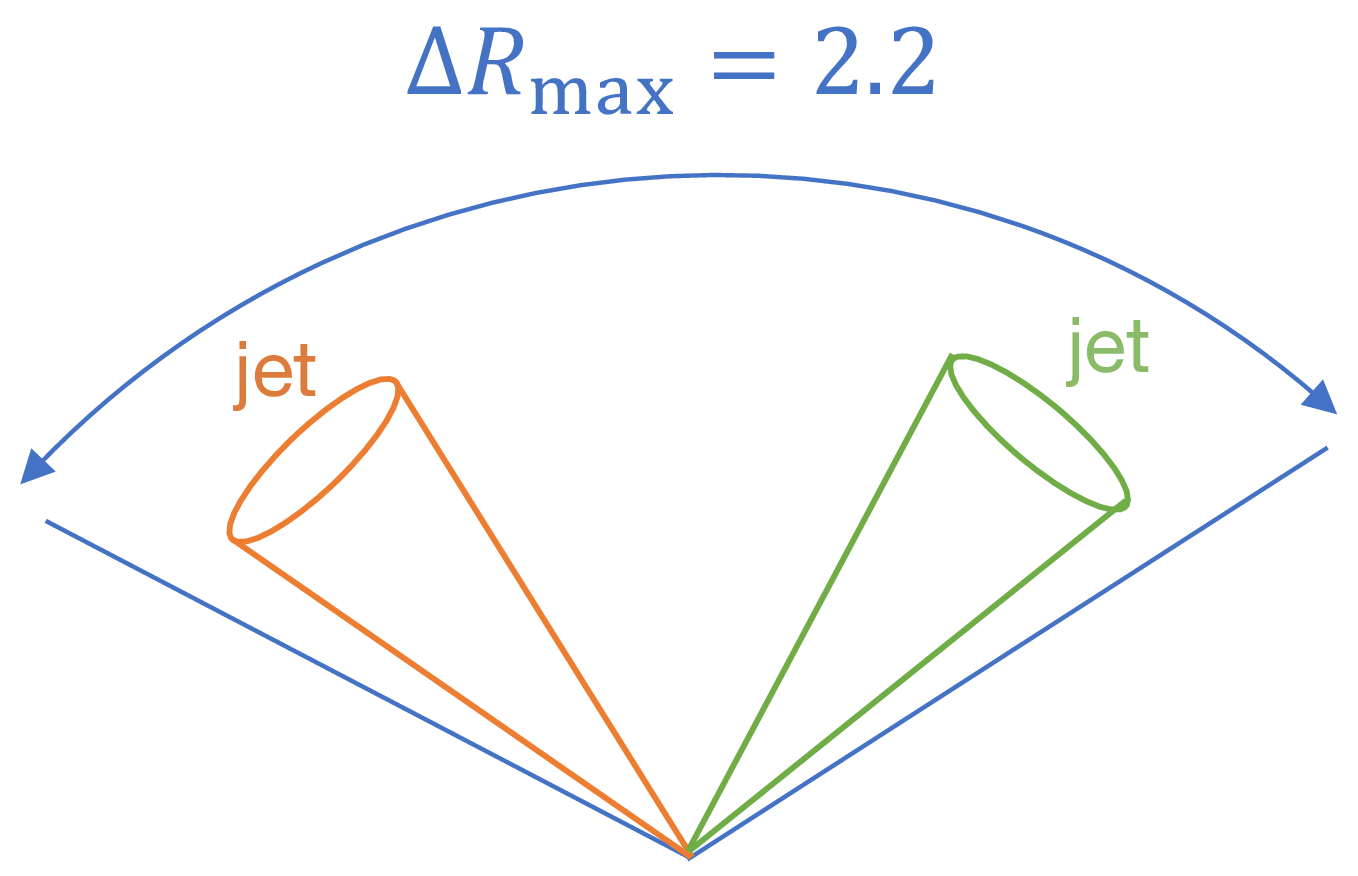
png pdf |
Additional Figure 20-a:
Reconstruction of a Higgs boson as two AK4 jets. |

png pdf |
Additional Figure 20-b:
Reconstruction of a Higgs boson as one AK4 jet. |

png pdf |
Additional Figure 21:
Typical configuration of (a) signal and (b) ${\mathrm{t} \mathrm{\bar{t}}}$ events with the resolved signature. In ${\mathrm{t} \mathrm{\bar{t}}}$ events, the presence of a misidentified b jet often results in a large value of $\Delta R_{bb}$ for one of the Higgs boson candidates. |

png pdf |
Additional Figure 21-a:
Typical configuration of signal events with the resolved signature. |
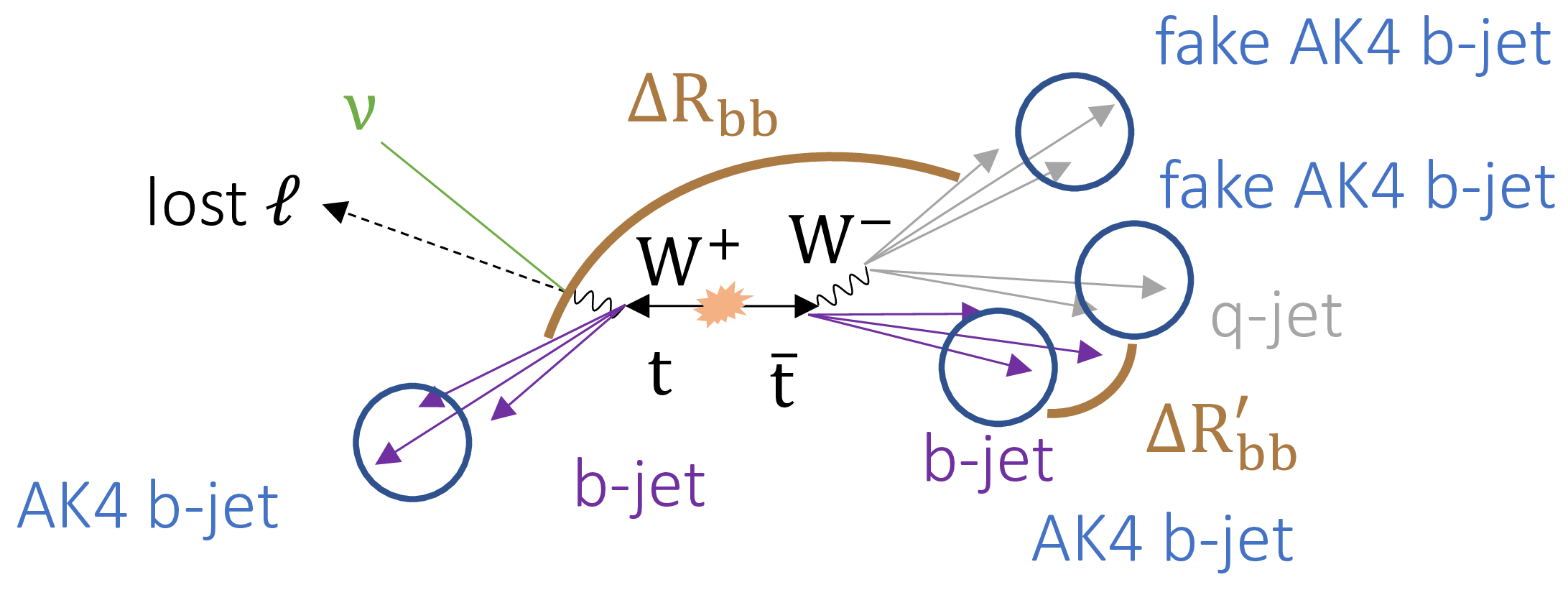
png pdf |
Additional Figure 21-b:
Typical configuration of signal ${\mathrm{t} \mathrm{\bar{t}}}$ events with the resolved signature. The presence of a misidentified b jet often results in a large value of $\Delta R_{bb}$ for one of the Higgs boson candidates. |

png pdf |
Additional Figure 22:
Typical configuration of (a) signal and (b) background events with the boosted signature. |

png pdf |
Additional Figure 22-a:
Typical configuration of signal events with the boosted signature. |

png pdf |
Additional Figure 22-b:
Typical configuration of background events with the boosted signature. |

png pdf |
Additional Figure 23:
Two dimensional distribution in simulated signal events (950 GeV higgsinos) of $\Delta R_{\mathrm{b} \mathrm{\bar{b}}}$ for the leading and subleading Higgs boson candidates, showing the approximate phase-space coverage of the resolved and boosted searches. The resolved phase space region extends from $\Delta R_{\mathrm{b} \mathrm{\bar{b}}} = $ 0.4 to 2.2, corresponding to the middle of the histogram, while the lower left part of the plot corresponds to the boosted phase space region. |

png pdf |
Additional Figure 24:
Analysis regions used for the (left) resolved and (right) boosted signatures, after the baseline selection requirements are applied. The signal and sideband regions used for the background estimation are indicated. Further binning in other kinematic variables is applied. |
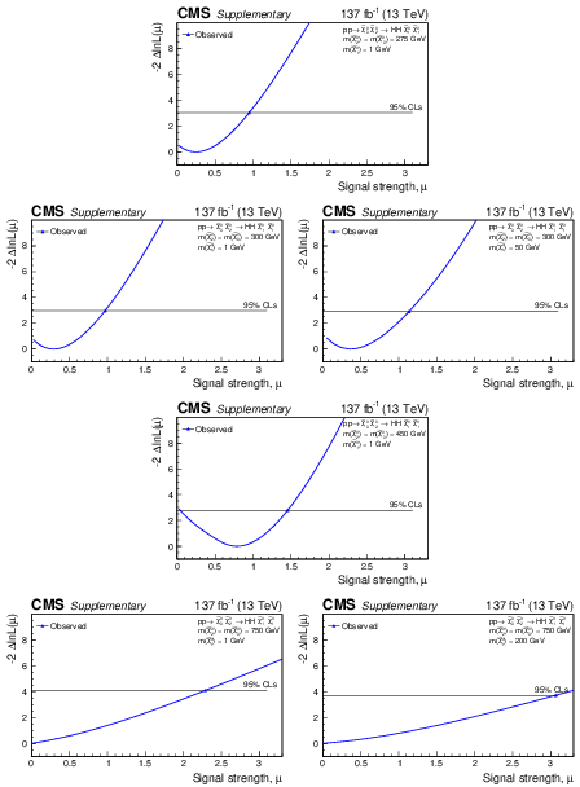
png pdf |
Additional Figure 25:
Profile likelihood functions for representative scan points for the TChiHH model. |

png pdf |
Additional Figure 25-a:
Profile likelihood function for a representative scan point for the TChiHH model. |
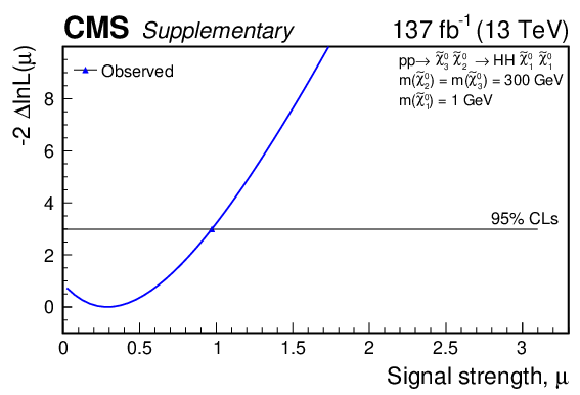
png pdf |
Additional Figure 25-b:
Profile likelihood function for a representative scan point for the TChiHH model. |
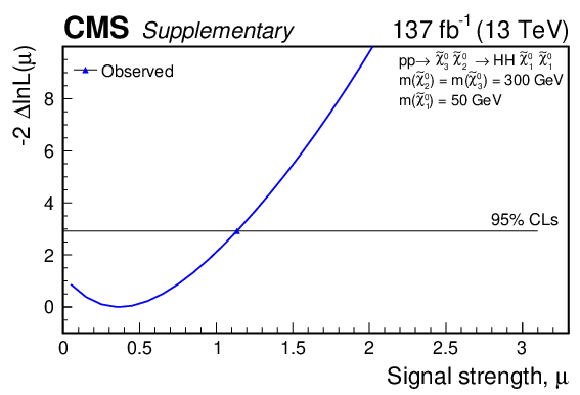
png pdf |
Additional Figure 25-c:
Profile likelihood function for a representative scan point for the TChiHH model. |
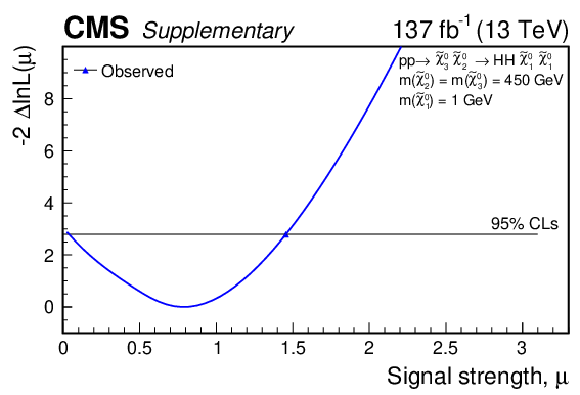
png pdf |
Additional Figure 25-d:
Profile likelihood function for a representative scan point for the TChiHH model. |
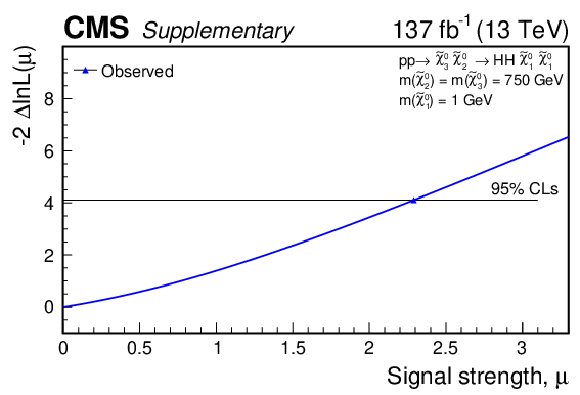
png pdf |
Additional Figure 25-e:
Profile likelihood function for a representative scan point for the TChiHH model. |
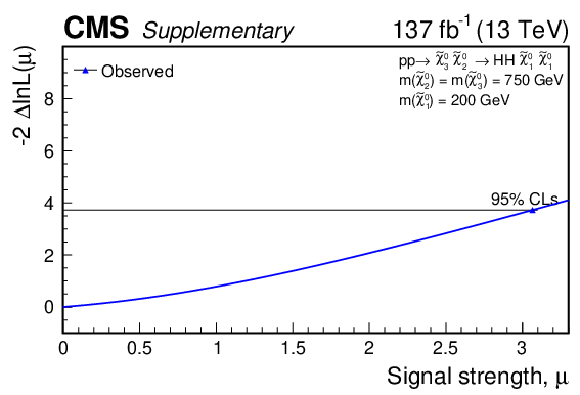
png pdf |
Additional Figure 25-f:
Profile likelihood function for a representative scan point for the TChiHH model. |
| Additional Tables | |

png pdf |
Additional Table 1:
Signal event efficiencies of the resolved topology for the TChiHH model with a 450 GeV higgsino mass and 1 GeV LSP mass. The denominator for the efficiency calculation includes only $\mathrm{H} \to \mathrm{b} \mathrm{\bar{b}} $ decays. |

png pdf |
Additional Table 2:
Signal event efficiencies of the boosted topology for the T5HH model with a 2200 GeV gluino mass. |

png pdf |
Additional Table 3:
Resolved results table, including the data yields in the 6 ABCD regions in each ${{p_{\mathrm {T}}} ^\text {miss}}$ -$\Delta R_{\text {max}}$ plane. |

png pdf |
Additional Table 4:
Boosted results table, including the data yields in the 6 analysis ABCD regions in each ${{p_{\mathrm {T}}} ^\text {miss}}$ bin. The data yields for the 0H+b control region, used to determine the ${{p_{\mathrm {T}}} ^\text {miss}}$ shape, are also included. |

png pdf |
Additional Table 5:
Cut flow table for the resolved topology showing expected event yields at 137 fb$^{-1}$ for selected signal models as successive selections are applied. The selections above the horizontal line correspond to the resolved topology baseline selection. |
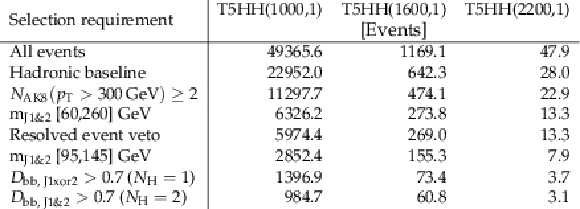
png pdf |
Additional Table 6:
Cut flow table for the boosted topology showing expected event yields at 137 fb$^{-1}$ for selected signal models as successive selections are applied. Here the hadronic baseline is defined by $N_{\mathrm {jet}}\geq $2, ${{p_{\mathrm {T}}} ^\text {miss}}$ $ > $300 GeV, $\Delta \phi $ cuts, and the isolated lepton and track vetoes. |
| References | ||||
| 1 | ATLAS Collaboration | Observation of a new particle in the search for the standard model Higgs boson with the ATLAS detector at the LHC | PLB 716 (2012) 1 | 1207.7214 |
| 2 | CMS Collaboration | Observation of a new boson at a mass of 125 GeV with the CMS experiment at the LHC | PLB 716 (2012) 30 | CMS-HIG-12-028 1207.7235 |
| 3 | CMS Collaboration | Observation of a new boson with mass near 125 GeV in pp collisions at $ \sqrt{s} = $ 7 and 8 TeV | JHEP 06 (2013) 081 | CMS-HIG-12-036 1303.4571 |
| 4 | ATLAS and CMS Collaborations | Combined measurement of the Higgs boson mass in pp collisions at $ \sqrt{s}= $ 7 and 8 TeV with the ATLAS and CMS experiments | PRL 114 (2015) 191803 | 1503.07589 |
| 5 | P. Ramond | Dual theory for free fermions | PRD 3 (1971) 2415 | |
| 6 | Y. A. Golfand and E. P. Likhtman | Extension of the algebra of Poincaré group generators and violation of P invariance | JEPTL 13 (1971)323 | |
| 7 | A. Neveu and J. H. Schwarz | Factorizable dual model of pions | NPB 31 (1971) 86 | |
| 8 | D. V. Volkov and V. P. Akulov | Possible universal neutrino interaction | JEPTL 16 (1972)438 | |
| 9 | J. Wess and B. Zumino | A Lagrangian model invariant under supergauge transformations | PLB 49 (1974) 52 | |
| 10 | J. Wess and B. Zumino | Supergauge transformations in four dimensions | NPB 70 (1974) 39 | |
| 11 | P. Fayet | Supergauge invariant extension of the Higgs mechanism and a model for the electron and its neutrino | NPB 90 (1975) 104 | |
| 12 | P. Fayet and S. Ferrara | Supersymmetry | PR 32 (1977) 249 | |
| 13 | H. P. Nilles | Supersymmetry, supergravity and particle physics | Phys. Rep. 110 (1984) 1 | |
| 14 | S. P. Martin | A supersymmetry primer | Adv. Ser. Direct. High Energy Phys. 21 (2010) 1 | hep-ph/9709356 |
| 15 | S. Dimopoulos and G. F. Giudice | Naturalness constraints in supersymmetric theories with nonuniversal soft terms | PLB 357 (1995) 573 | hep-ph/9507282 |
| 16 | R. Barbieri and D. Pappadopulo | S-particles at their naturalness limits | JHEP 10 (2009) 061 | 0906.4546 |
| 17 | M. Papucci, J. T. Ruderman, and A. Weiler | Natural SUSY endures | JHEP 09 (2012) 035 | 1110.6926 |
| 18 | LHC Higgs Cross Section Working Group | Handbook of LHC Higgs cross sections: 4. deciphering the nature of the Higgs sector | CERN (2016) | 1610.07922 |
| 19 | ATLAS Collaboration | Search for supersymmetry in events with photons, bottom quarks, and missing transverse momentum in proton-proton collisions at a centre-of-mass energy of 7 TeV with the ATLAS detector | PLB 719 (2013) 261 | 1211.1167 |
| 20 | ATLAS Collaboration | Search for direct pair production of a chargino and a neutralino decaying to the 125 GeV Higgs boson in $ \sqrt{s} = $ 8 TeV pp collisions with the ATLAS detector | EPJC 75 (2015) 208 | 1501.07110 |
| 21 | ATLAS Collaboration | Search for supersymmetry in final states with two same-sign or three leptons and jets using 36 fb$ ^{-1} $ of $ \sqrt{s}= $ 13 TeV pp collision data with the ATLAS detector | JHEP 09 (2017) 084 | 1706.03731 |
| 22 | ATLAS Collaboration | Search for new phenomena with large jet multiplicities and missing transverse momentum using large-radius jets and flavour-tagging at ATLAS in 13 TeV pp collisions | JHEP 12 (2017) 034 | 1708.02794 |
| 23 | ATLAS Collaboration | Search for squarks and gluinos in events with an isolated lepton, jets, and missing transverse momentum at $ \sqrt{s}= $ 13 TeV with the ATLAS detector | PRD 96 (2017) 112010 | 1708.08232 |
| 24 | ATLAS Collaboration | Search for squarks and gluinos in final states with jets and missing transverse momentum using 36 fb$ ^{-1} $ of $ \sqrt{s}= $ 13 TeV pp collision data with the ATLAS detector | PRD 97 (2018) 112001 | 1712.02332 |
| 25 | ATLAS Collaboration | Search for electroweak production of supersymmetric states in scenarios with compressed mass spectra at $ \sqrt{s}= $ 13 TeV with the ATLAS detector | PRD 97 (2018) 052010 | 1712.08119 |
| 26 | ATLAS Collaboration | Search for photonic signatures of gauge-mediated supersymmetry in 13 TeV pp collisions with the ATLAS detector | PRD 97 (2018) 092006 | 1802.03158 |
| 27 | ATLAS Collaboration | Search for electroweak production of supersymmetric particles in final states with two or three leptons at $ \sqrt{s}= $ 13 TeV with the ATLAS detector | EPJC 78 (2018) 995 | 1803.02762 |
| 28 | ATLAS Collaboration | Search for chargino-neutralino production using recursive jigsaw reconstruction in final states with two or three charged leptons in proton-proton collisions at $ \sqrt{s}= $ 13 TeV with the ATLAS detector | PRD 98 (2018) 092012 | 1806.02293 |
| 29 | ATLAS Collaboration | Search for pair production of higgsinos in final states with at least three $ b $-tagged jets in $ \sqrt{s} = $ 13 TeV pp collisions using the ATLAS detector | PRD 98 (2018) 092002 | 1806.04030 |
| 30 | ATLAS Collaboration | Search for chargino and neutralino production in final states with a Higgs boson and missing transverse momentum at $ \sqrt{s} = $ 13 TeV with the ATLAS detector | PRD 100 (2019) 012006 | 1812.09432 |
| 31 | ATLAS Collaboration | Search for electroweak production of charginos and sleptons decaying into final states with two leptons and missing transverse momentum in $ \sqrt{s}= $ 13 TeV pp collisions using the ATLAS detector | EPJC 80 (2020) 123 | 1908.08215 |
| 32 | ATLAS Collaboration | Search for direct production of electroweakinos in final states with one lepton, missing transverse momentum and a Higgs boson decaying into two $ b $-jets in pp collisions at $ \sqrt{s}= $ 13 TeV with the ATLAS detector | EPJC 80 (2020) 691 | 1909.09226 |
| 33 | ATLAS Collaboration | Searches for electroweak production of supersymmetric particles with compressed mass spectra in $ \sqrt{s}= $ 13 TeV pp collisions with the ATLAS detector | PRD 101 (2020) 052005 | 1911.12606 |
| 34 | ATLAS Collaboration | Search for chargino-neutralino production with mass splittings near the electroweak scale in three-lepton final states in $ \sqrt {s} = $ 13 TeV pp collisions with the ATLAS detector | PRD 101 (2020) 072001 | 1912.08479 |
| 35 | ATLAS Collaboration | Search for direct production of electroweakinos in final states with missing transverse momentum and a Higgs boson decaying into photons in pp collisions at $ \sqrt{s} = $ 13 TeV with the ATLAS detector | JHEP 10 (2020) 005 | 2004.10894 |
| 36 | ATLAS Collaboration | Search for supersymmetry in events with four or more charged leptons in 139 fb$^{-1}$ of $ \sqrt{s}= $ 13 TeV pp collisions with the ATLAS detector | JHEP 07 (2021) 167 | 2103.11684 |
| 37 | ATLAS Collaboration | Search for charginos and neutralinos in final states with two boosted hadronically decaying bosons and missing transverse momentum in pp collisions at $ \sqrt{s}= $ 13 TeV with the ATLAS detector | PRD 104 (2021), no. 11, 112010 | 2108.07586 |
| 38 | CMS Collaboration | Searches for electroweak production of charginos, neutralinos, and sleptons decaying to leptons and W, Z, and Higgs bosons in pp collisions at 8 TeV | EPJC 74 (2014) 3036 | CMS-SUS-13-006 1405.7570 |
| 39 | CMS Collaboration | Search for top squark and higgsino production using diphoton Higgs boson decays | PRL 112 (2014) 161802 | CMS-SUS-13-014 1312.3310 |
| 40 | CMS Collaboration | Searches for electroweak neutralino and chargino production in channels with Higgs, Z, and W bosons in pp collisions at 8 TeV | PRD 90 (2014) 092007 | CMS-SUS-14-002 1409.3168 |
| 41 | CMS Collaboration | Search for physics beyond the standard model in events with two leptons of same sign, missing transverse momentum, and jets in proton-proton collisions at $ \sqrt{s} = $ 13 TeV | EPJC 77 (2017) 578 | CMS-SUS-16-035 1704.07323 |
| 42 | CMS Collaboration | Search for electroweak production of charginos and neutralinos in WH events in proton-proton collisions at $ \sqrt{s}= $ 13 TeV | JHEP 11 (2017) 029 | CMS-SUS-16-043 1706.09933 |
| 43 | CMS Collaboration | Search for supersymmetry in events with at least one photon, missing transverse momentum, and large transverse event activity in proton-proton collisions at $ \sqrt{s}= $ 13 TeV | JHEP 12 (2017) 142 | CMS-SUS-16-047 1707.06193 |
| 44 | CMS Collaboration | Search for supersymmetry with Higgs boson to diphoton decays using the razor variables at $ \sqrt{s} = $ 13 TeV | PLB 779 (2018) 166 | CMS-SUS-16-045 1709.00384 |
| 45 | CMS Collaboration | Search for higgsino pair production in pp collisions at $ \sqrt{s} = $ 13 TeV in final states with large missing transverse momentum and two Higgs bosons decaying via $\mathrm{ H \to b \bar b }$ | PRD 97 (2018) 032007 | CMS-SUS-16-044 1709.04896 |
| 46 | CMS Collaboration | Combined search for electroweak production of charginos and neutralinos in proton-proton collisions at $ \sqrt{s} = $ 13 TeV | JHEP 03 (2018) 160 | CMS-SUS-17-004 1801.03957 |
| 47 | CMS Collaboration | Search for new phenomena in final states with two opposite-charge, same-flavor leptons, jets, and missing transverse momentum in pp collisions at $ \sqrt{s}= $ 13 TeV | JHEP 03 (2018) 076 | CMS-SUS-16-034 1709.08908 |
| 48 | CMS Collaboration | Search for supersymmetry in events with one lepton and multiple jets exploiting the angular correlation between the lepton and the missing transverse momentum in proton-proton collisions at $ \sqrt{s} = $ 13 TeV | PLB 780 (2018) 384 | CMS-SUS-16-042 1709.09814 |
| 49 | CMS Collaboration | Search for supersymmetry in events with at least three electrons or muons, jets, and missing transverse momentum in proton-proton collisions at $ \sqrt{s}= $ 13 TeV | JHEP 02 (2018) 067 | CMS-SUS-16-041 1710.09154 |
| 50 | CMS Collaboration | Search for gauge-mediated supersymmetry in events with at least one photon and missing transverse momentum in pp collisions at $ \sqrt{s} = $ 13 TeV | PLB 780 (2018) 118 | CMS-SUS-16-046 1711.08008 |
| 51 | CMS Collaboration | Search for physics beyond the standard model in events with high-momentum Higgs bosons and missing transverse momentum in proton-proton collisions at 13 TeV | PRL 120 (2018) 241801 | CMS-SUS-17-006 1712.08501 |
| 52 | CMS Collaboration | Search for new physics in events with two soft oppositely charged leptons and missing transverse momentum in proton-proton collisions at $ \sqrt{s}= $ 13 TeV | PLB 782 (2018) 440 | CMS-SUS-16-048 1801.01846 |
| 53 | CMS Collaboration | Searches for pair production of charginos and top squarks in final states with two oppositely charged leptons in proton-proton collisions at $ \sqrt{s}= $ 13 TeV | JHEP 11 (2018) 079 | CMS-SUS-17-010 1807.07799 |
| 54 | CMS Collaboration | Search for supersymmetry in events with a photon, a lepton, and missing transverse momentum in proton-proton collisions at $ \sqrt{s} = $ 13 TeV | JHEP 01 (2019) 154 | CMS-SUS-17-012 1812.04066 |
| 55 | CMS Collaboration | Search for supersymmetry in events with a photon, jets, b-jets, and missing transverse momentum in proton-proton collisions at 13 TeV | EPJC 79 (2019) 444 | CMS-SUS-18-002 1901.06726 |
| 56 | CMS Collaboration | Search for supersymmetry in final states with photons and missing transverse momentum in proton-proton collisions at 13 TeV | JHEP 06 (2019) 143 | CMS-SUS-17-011 1903.07070 |
| 57 | CMS Collaboration | Combined search for supersymmetry with photons in proton-proton collisions at $ \sqrt{s}= $ 13 TeV | PLB 801 (2020) 135183 | CMS-SUS-18-005 1907.00857 |
| 58 | CMS Collaboration | Search for supersymmetry using Higgs boson to diphoton decays at $ \sqrt{s} = $ 13 TeV | JHEP 11 (2019) 109 | CMS-SUS-18-007 1908.08500 |
| 59 | CMS Collaboration | Searches for physics beyond the standard model with the $ M_\mathrm{T2} $ variable in hadronic final states with and without disappearing tracks in proton-proton collisions at $ \sqrt{s}= $ 13 TeV | EPJC 80 (2020) 3 | CMS-SUS-19-005 1909.03460 |
| 60 | CMS Collaboration | Search for physics beyond the standard model in events with jets and two same-sign or at least three charged leptons in proton-proton collisions at $ \sqrt{s}= $ 13 TeV | EPJC 80 (2020) 752 | CMS-SUS-19-008 2001.10086 |
| 61 | CMS Collaboration | Search for supersymmetry in proton-proton collisions at $ \sqrt{s} = $ 13 TeV in events with high-momentum Z bosons and missing transverse momentum | JHEP 09 (2020) 149 | CMS-SUS-19-013 2008.04422 |
| 62 | CMS Collaboration | Search for supersymmetry in final states with two oppositely charged same-flavor leptons and missing transverse momentum in proton-proton collisions at $ \sqrt{s} = $ 13 TeV | JHEP 04 (2021) 123 | CMS-SUS-20-001 2012.08600 |
| 63 | CMS Collaboration | Search for electroweak production of charginos and neutralinos in proton-proton collisions at $ \sqrt{s} = $ 13 TeV | JHEP 04 (2022) 147 | CMS-SUS-19-012 2106.14246 |
| 64 | CMS Collaboration | Search for chargino-neutralino production in events with Higgs and W bosons using 137 fb$ ^{-1} $ of proton-proton collisions at $ \sqrt{s} = $ 13 TeV | JHEP 10 (2021) 045 | CMS-SUS-20-003 2107.12553 |
| 65 | CMS Collaboration | HEPData record for this analysis | link | |
| 66 | Particle Data Group, P. A. Zyla et al. | Review of particle physics | Prog. Theor. Exp. Phys. 2020 (2020) 083C01 | |
| 67 | G. R. Farrar and P. Fayet | Phenomenology of the production, decay, and detection of new hadronic states associated with supersymmetry | PLB 76 (1978) 575 | |
| 68 | N. Arkani-Hamed et al. | MARMOSET: The path from LHC data to the new standard model via on-shell effective theories | hep-ph/0703088 | |
| 69 | J. Alwall, P. Schuster, and N. Toro | Simplified models for a first characterization of new physics at the LHC | PRD 79 (2009) 075020 | 0810.3921 |
| 70 | J. Alwall, M.-P. Le, M. Lisanti, and J. G. Wacker | Model-independent jets plus missing energy searches | PRD 79 (2009) 015005 | 0809.3264 |
| 71 | D. Alves et al. | Simplified models for LHC new physics searches | JPG 39 (2012) 105005 | 1105.2838 |
| 72 | S. Dimopoulos, M. Dine, S. Raby, and S. D. Thomas | Experimental signatures of low-energy gauge mediated supersymmetry breaking | PRL 76 (1996) 3494 | hep-ph/9601367 |
| 73 | K. T. Matchev and S. D. Thomas | Higgs and Z boson signatures of supersymmetry | PRD 62 (2000) 077702 | hep-ph/9908482 |
| 74 | J. T. Ruderman and D. Shih | General neutralino NLSPs at the early LHC | JHEP 08 (2012) 159 | 1103.6083 |
| 75 | B. Fuks, M. Klasen, D. R. Lamprea, and M. Rothering | Gaugino production in proton-proton collisions at a center-of-mass energy of 8 TeV | JHEP 10 (2012) 081 | 1207.2159 |
| 76 | B. Fuks, M. Klasen, D. R. Lamprea, and M. Rothering | Precision predictions for electroweak superpartner production at hadron colliders with Resummino | EPJC 73 (2013) 2480 | 1304.0790 |
| 77 | H. Baer et al. | Natural SUSY with a bino- or wino-like LSP | PRD 91 (2015) 075005 | 1501.06357 |
| 78 | Z. Kang, P. Ko, and J. Li | New physics opportunities in the boosted di-Higgs-boson plus missing transverse energy signature | PRL 116 (2016) 131801 | 1504.04128 |
| 79 | G. D. Kribs, A. Martin, T. S. Roy, and M. Spannowsky | Discovering Higgs bosons of the MSSM using jet substructure | PRD 82 (2010) 095012 | 1006.1656 |
| 80 | S. Gori, P. Schwaller, and C. E. M. Wagner | Search for Higgs bosons in SUSY cascade decays and neutralino dark matter | PRD 83 (2011) 115022 | 1103.4138 |
| 81 | E. Arganda, A. Delgado, R. A. Morales, and M. Quirós | Novel Higgsino dark matter signal interpretation at the LHC | PRD 104 (2021), no. 5, 055003 | 2104.13827 |
| 82 | A. Delgado and M. Quirós | Higgsino Dark Matter in the MSSM | PRD 103 (2021), no. 1, 015024 | 2008.00954 |
| 83 | CMS Collaboration | The CMS experiment at the CERN LHC | JINST 3 (2008) S08004 | CMS-00-001 |
| 84 | CMS Collaboration | Performance of the CMS Level-1 trigger in proton-proton collisions at $ \sqrt{s} = $ 13 TeV | JINST 15 (2020) P10017 | CMS-TRG-17-001 2006.10165 |
| 85 | CMS Collaboration | The CMS trigger system | JINST 12 (2017) P01020 | CMS-TRG-12-001 1609.02366 |
| 86 | CMS Collaboration | Pileup mitigation at CMS in 13 TeV data | JINST 15 (2020) P09018 | CMS-JME-18-001 2003.00503 |
| 87 | J. Alwall et al. | The automated computation of tree-level and next-to-leading order differential cross sections, and their matching to parton shower simulations | JHEP 07 (2014) 079 | 1405.0301 |
| 88 | J. Alwall et al. | Comparative study of various algorithms for the merging of parton showers and matrix elements in hadronic collisions | EPJC 53 (2008) 473 | 0706.2569 |
| 89 | R. Frederix and S. Frixione | Merging meets matching in MC@NLO | JHEP 12 (2012) 061 | 1209.6215 |
| 90 | P. Nason | A new method for combining NLO QCD with shower Monte Carlo algorithms | JHEP 11 (2004) 040 | hep-ph/0409146 |
| 91 | S. Frixione, P. Nason, and C. Oleari | Matching NLO QCD computations with parton shower simulations: the POWHEG method | JHEP 11 (2007) 070 | 0709.2092 |
| 92 | S. Alioli, P. Nason, C. Oleari, and E. Re | A general framework for implementing NLO calculations in shower Monte Carlo programs: the POWHEG BOX | JHEP 06 (2010) 043 | 1002.2581 |
| 93 | S. Alioli, P. Nason, C. Oleari, and E. Re | NLO single-top production matched with shower in POWHEG: $ s $- and $ t $-channel contributions | JHEP 09 (2009) 111 | 0907.4076 |
| 94 | E. Re | Single-top Wt-channel production matched with parton showers using the POWHEG method | EPJC 71 (2011) 1547 | 1009.2450 |
| 95 | W. Beenakker, R. Hopker, M. Spira, and P. M. Zerwas | Squark and gluino production at hadron colliders | NPB 492 (1997) 51 | hep-ph/9610490 |
| 96 | A. Kulesza and L. Motyka | Threshold resummation for squark-antisquark and gluino-pair production at the LHC | PRL 102 (2009) 111802 | 0807.2405 |
| 97 | A. Kulesza and L. Motyka | Soft gluon resummation for the production of gluino-gluino and squark-antisquark pairs at the LHC | PRD 80 (2009) 095004 | 0905.4749 |
| 98 | W. Beenakker et al. | Soft-gluon resummation for squark and gluino hadroproduction | JHEP 12 (2009) 041 | 0909.4418 |
| 99 | W. Beenakker et al. | Squark and gluino hadroproduction | Int. J. Mod. Phys. A 26 (2011) 2637 | 1105.1110 |
| 100 | W. Beenakker et al. | NNLL-fast: predictions for coloured supersymmetric particle production at the LHC with threshold and Coulomb resummation | JHEP 12 (2016) 133 | 1607.07741 |
| 101 | W. Beenakker et al. | NNLL resummation for squark-antisquark pair production at the LHC | JHEP 01 (2012) 076 | 1110.2446 |
| 102 | W. Beenakker et al. | Towards NNLL resummation: hard matching coefficients for squark and gluino hadroproduction | JHEP 10 (2013) 120 | 1304.6354 |
| 103 | W. Beenakker et al. | NNLL resummation for squark and gluino production at the LHC | JHEP 12 (2014) 023 | 1404.3134 |
| 104 | W. Beenakker et al. | Stop production at hadron colliders | NPB 515 (1998) 3 | hep-ph/9710451 |
| 105 | W. Beenakker et al. | Supersymmetric top and bottom squark production at hadron colliders | JHEP 08 (2010) 098 | 1006.4771 |
| 106 | W. Beenakker et al. | NNLL resummation for stop pair-production at the LHC | JHEP 05 (2016) 153 | 1601.02954 |
| 107 | S. Abdullin et al. | The fast simulation of the CMS detector at LHC | J. Phys. Conf. Ser. 331 (2011) 032049 | |
| 108 | T. Sjostrand et al. | An introduction to PYTHIA 8.2 | CPC 191 (2015) 159 | 1410.3012 |
| 109 | CMS Collaboration | Event generator tunes obtained from underlying event and multiparton scattering measurements | EPJC 76 (2016) 155 | CMS-GEN-14-001 1512.00815 |
| 110 | CMS Collaboration | Extraction and validation of a new set of CMS PYTHIA-8 tunes from underlying-event measurements | EPJC 80 (2020) 4 | CMS-GEN-17-001 1903.12179 |
| 111 | NNPDF Collaboration | Parton distributions with QED corrections | NPB 877 (2013) 290 | 1308.0598 |
| 112 | NNPDF Collaboration | Parton distributions from high-precision collider data | EPJC 77 (2017) 663 | 1706.00428 |
| 113 | GEANT4 Collaboration | GEANT4--a simulation toolkit | NIMA 506 (2003) 250 | |
| 114 | T. Melia, P. Nason, R. Rontsch, and G. Zanderighi | W$ ^+ $W$ ^- $, WZ and ZZ production in the POWHEG BOX | JHEP 11 (2011) 078 | 1107.5051 |
| 115 | M. Beneke, P. Falgari, S. Klein, and C. Schwinn | Hadronic top-quark pair production with NNLL threshold resummation | NPB 855 (2012) 695 | 1109.1536 |
| 116 | M. Cacciari et al. | Top-pair production at hadron colliders with next-to-next-to-leading logarithmic soft-gluon resummation | PLB 710 (2012) 612 | 1111.5869 |
| 117 | P. Barnreuther, M. Czakon, and A. Mitov | Percent level precision physics at the Tevatron: first genuine NNLO QCD corrections to $ \mathrm{q\bar{q}}\to\mathrm{t\bar{t}} $+X | PRL 109 (2012) 132001 | 1204.5201 |
| 118 | M. Czakon and A. Mitov | NNLO corrections to top-pair production at hadron colliders: the all-fermionic scattering channels | JHEP 12 (2012) 054 | 1207.0236 |
| 119 | M. Czakon and A. Mitov | NNLO corrections to top pair production at hadron colliders: the quark-gluon reaction | JHEP 01 (2013) 080 | 1210.6832 |
| 120 | M. Czakon, P. Fiedler, and A. Mitov | Total top-quark pair-production cross section at hadron colliders through $ \mathcal{O}({\alpha_S}^4) $ | PRL 110 (2013) 252004 | 1303.6254 |
| 121 | R. Gavin, Y. Li, F. Petriello, and S. Quackenbush | W physics at the LHC with FEWZ 2.1 | CPC 184 (2013) 208 | 1201.5896 |
| 122 | R. Gavin, Y. Li, F. Petriello, and S. Quackenbush | FEWZ 2.0: A code for hadronic Z production at next-to-next-to-leading order | CPC 182 (2011) 2388 | 1011.3540 |
| 123 | A. Giammanco | The fast simulation of the CMS experiment | J. Phys. Conf. Ser. 513 (2014) 022012 | |
| 124 | CMS Collaboration | Particle-flow reconstruction and global event description with the CMS detector | JINST 12 (2017) P10003 | CMS-PRF-14-001 1706.04965 |
| 125 | CMS Collaboration | Technical proposal for the Phase-II upgrade of the Compact Muon Solenoid | CMS-PAS-TDR-15-002 | CMS-PAS-TDR-15-002 |
| 126 | M. Cacciari, G. P. Salam, and G. Soyez | The anti-$ {k_{\mathrm{T}}} $ jet clustering algorithm | JHEP 04 (2008) 063 | 0802.1189 |
| 127 | M. Cacciari, G. P. Salam, and G. Soyez | FastJet user manual | EPJC 72 (2012) 1896 | 1111.6097 |
| 128 | CMS Collaboration | Jet performance in pp collisions at $ \sqrt{s}= $ 7 TeV | CMS-PAS-JME-10-003 | |
| 129 | CMS Collaboration | Jet algorithms performance in 13 TeV data | CMS-PAS-JME-16-003 | CMS-PAS-JME-16-003 |
| 130 | CMS Collaboration | Jet energy scale and resolution in the CMS experiment in pp collisions at 8 TeV | JINST 12 (2017) P02014 | CMS-JME-13-004 1607.03663 |
| 131 | M. Cacciari and G. P. Salam | Pileup subtraction using jet areas | PLB 659 (2008) 119 | 0707.1378 |
| 132 | D. Bertolini, P. Harris, M. Low, and N. Tran | Pileup per particle identification | JHEP 10 (2014) 059 | 1407.6013 |
| 133 | CMS Collaboration | Search for top-squark pair production in the single-lepton final state in pp collisions at $ \sqrt{s} = $ 8 TeV | EPJC 73 (2013) 2677 | CMS-SUS-13-011 1308.1586 |
| 134 | CMS Collaboration | Identification of heavy-flavour jets with the CMS detector in pp collisions at 13 TeV | JINST 13 (2018) P05011 | CMS-BTV-16-002 1712.07158 |
| 135 | CMS Collaboration | Performance of deep tagging algorithms for boosted double quark jet topology in proton-proton collisions at 13 TeV with the Phase-0 CMS detector | CDS | |
| 136 | CMS Collaboration | Performance of missing transverse momentum reconstruction in proton-proton collisions at $ \sqrt{s} = $ 13 TeV using the CMS detector | JINST 14 (2019) P07004 | CMS-JME-17-001 1903.06078 |
| 137 | CMS Collaboration | Electron and photon reconstruction and identification with the CMS experiment at the CERN LHC | JINST 16 (2021) P05014 | CMS-EGM-17-001 2012.06888 |
| 138 | CMS Collaboration | Performance of the CMS muon detector and muon reconstruction with proton-proton collisions at $ \sqrt{s} = $ 13 TeV | JINST 13 (2018) P06015 | CMS-MUO-16-001 1804.04528 |
| 139 | K. Rehermann and B. Tweedie | Efficient identification of boosted semileptonic top quarks at the LHC | JHEP 03 (2011) 059 | 1007.2221 |
| 140 | A. J. Larkoski, S. Marzani, G. Soyez, and J. Thaler | Soft drop | JHEP 05 (2014) 146 | 1402.2657 |
| 141 | M. Dasgupta, A. Fregoso, S. Marzani, and G. P. Salam | Towards an understanding of jet substructure | JHEP 09 (2013) 029 | 1307.0007 |
| 142 | A. Kalogeropoulos and J. Alwall | The SysCalc code: A tool to derive theoretical systematic uncertainties | 1801.08401 | |
| 143 | S. Catani, D. de Florian, M. Grazzini, and P. Nason | Soft gluon resummation for Higgs boson production at hadron colliders | JHEP 07 (2003) 028 | hep-ph/0306211 |
| 144 | M. Cacciari et al. | The $ \mathrm{t\bar{t}} $ cross-section at 1.8 TeV and 1.96 TeV: a study of the systematics due to parton densities and scale dependence | JHEP 04 (2004) 068 | hep-ph/0303085 |
| 145 | CMS Collaboration | Measurement of the inelastic proton-proton cross section at $ \sqrt{s}= $ 13 TeV | JHEP 07 (2018) 161 | CMS-FSQ-15-005 1802.02613 |
| 146 | CMS Collaboration | Precision luminosity measurement in proton-proton collisions at $ \sqrt{s} = $ 13 TeV in 2015 and 2016 at CMS | EPJC 81 (2021) 800 | CMS-LUM-17-003 2104.01927 |
| 147 | CMS Collaboration | CMS luminosity measurement for the 2017 data-taking period at $ \sqrt{s} = $ 13 TeV | CMS-PAS-LUM-17-004 | CMS-PAS-LUM-17-004 |
| 148 | CMS Collaboration | CMS luminosity measurement for the 2018 data-taking period at $ \sqrt{s}= $ 13 TeV | CMS-PAS-LUM-18-002 | CMS-PAS-LUM-18-002 |
| 149 | G. Cowan, K. Cranmer, E. Gross, and O. Vitells | Asymptotic formulae for likelihood-based tests of new physics | EPJC 71 (2011) 1554 | 1007.1727 |
| 150 | T. Junk | Confidence level computation for combining searches with small statistics | NIMA 434 (1999) 435 | hep-ex/9902006 |
| 151 | A. L. Read | Presentation of search results: the CLs technique | JPG 28 (2002) 2693 | |
| 152 | G. Cowan | Statistics for searches at the LHC | in LHC Phenomenology, E. Gardi, N. Glover, and R. Aidan, eds Springer, Cham, 2015 Scottish Graduate Series | |

|
Compact Muon Solenoid LHC, CERN |

|

|

|

|

|

|